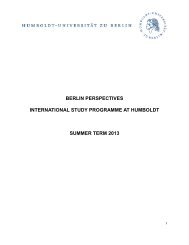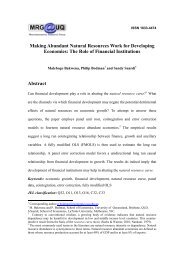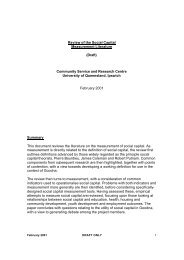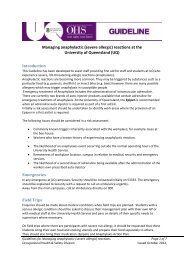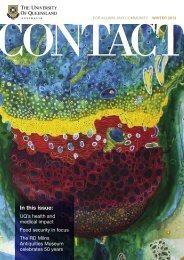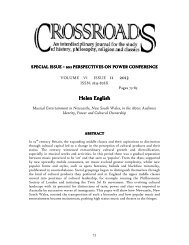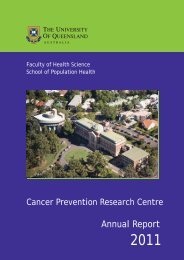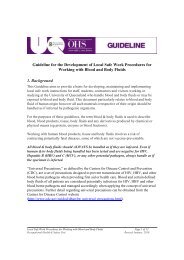The Emergence of a Small World in a Network of Research Joint ...
The Emergence of a Small World in a Network of Research Joint ...
The Emergence of a Small World in a Network of Research Joint ...
You also want an ePaper? Increase the reach of your titles
YUMPU automatically turns print PDFs into web optimized ePapers that Google loves.
<strong>The</strong> <strong>Emergence</strong> <strong>of</strong> a <strong>Small</strong> <strong>World</strong> <strong>in</strong> a <strong>Network</strong> <strong>of</strong><br />
<strong>Research</strong> Jo<strong>in</strong>t Ventures 1<br />
Mohamad Alghamdi<br />
School <strong>of</strong> Mathematics and Physics, <strong>The</strong> University <strong>of</strong> Queensland, Brisbane QLD, Australia<br />
Department <strong>of</strong> Mathematics, K<strong>in</strong>g Saud University, Riyadh, Saudi-Arabia.<br />
Stuart McDonald 2<br />
School <strong>of</strong> Economics and the Global Change Institute, <strong>The</strong> University <strong>of</strong> Queensland,<br />
Brisbane QLD 4072 Australia<br />
Bernard Pailthorpe<br />
School <strong>of</strong> Mathematics and Physics and the <strong>Research</strong> Comput<strong>in</strong>g Centre, <strong>The</strong> University <strong>of</strong><br />
Queensland, Brisbane QLD, Australia<br />
Abstract: Us<strong>in</strong>g a data set spann<strong>in</strong>g the period 1899-2000, we construct a network <strong>of</strong> RJVs and track<br />
the pattern <strong>of</strong> growth <strong>of</strong> this network over time. <strong>The</strong> result<strong>in</strong>g R&D network is emergent <strong>in</strong> the sense<br />
that RJVs are conta<strong>in</strong>ed with<strong>in</strong> it, connected to other RJVs by the existence firms shar<strong>in</strong>g membership<br />
with multiple RJVs. This paper shows that the largest growth <strong>in</strong> the R&D networks occurred dur<strong>in</strong>g<br />
the last three decades <strong>of</strong> the Twentieth Century. Dur<strong>in</strong>g this growth period, the R&D network has a<br />
pattern <strong>of</strong> collaboration that can be characterized as hav<strong>in</strong>g the “small world” property. This has<br />
implications for the rate <strong>of</strong> <strong>in</strong>formation diffusion across the network, as it implies that many noncollaborat<strong>in</strong>g<br />
firms are <strong>in</strong> fact quite close to each other <strong>in</strong> terms <strong>of</strong> degree <strong>of</strong> separation. We show that<br />
this network structure is due to the presence <strong>of</strong> a small number <strong>of</strong> highly connected firms that<br />
collaborate across multiple RJVs. <strong>The</strong>se firms have an important characteristic <strong>in</strong> that without their<br />
presence <strong>in</strong> the network, the R&D network looses its cohesiveness and the small world property<br />
disappears. Hence, these highly connected firms have an important role to play <strong>in</strong> determ<strong>in</strong><strong>in</strong>g the<br />
overall robustness <strong>of</strong> the R&D network.<br />
Key Words: <strong>Research</strong> and Development (R&D); <strong>Research</strong> Jo<strong>in</strong>t Ventures (RJVs); R&D <strong>Network</strong>s;<br />
<strong>Small</strong> <strong>World</strong>s; Social <strong>Network</strong> Analysis.<br />
JEL Classification: L14; L24<br />
1 <strong>The</strong> authors acknowledge Neil Kay for facilitat<strong>in</strong>g the license for use the MERIT-CATI database at <strong>The</strong><br />
University <strong>of</strong> Queensland. <strong>The</strong> authors acknowledge useful and detailed comments by Azhar Potia, Marco Van<br />
Der Liej, Tom Mandeville, Priscilla Man and David Rooney on an earlier draft <strong>of</strong> this manuscript. Stuart<br />
McDonald acknowledges fund<strong>in</strong>g support from a Global Change Institute <strong>Small</strong> Grant and University <strong>of</strong><br />
Queensland Early Career <strong>Research</strong>er Grant. Mohamad Alghamdi acknowledges scholarship support from the<br />
K<strong>in</strong>g Saud University.<br />
2<br />
Correspond<strong>in</strong>g author contact: s.mcdonald@uq.edu.au<br />
1
1 Introduction<br />
<strong>The</strong> objective <strong>of</strong> this paper is to characterize the pattern <strong>of</strong> evolution for network alliances<br />
between firms participat<strong>in</strong>g <strong>in</strong> research jo<strong>in</strong>t ventures (RJVs) dur<strong>in</strong>g the Twentieth Century.<br />
In order to do this, we use the Cooperative Agreements and Technology Indicators (MERIT-<br />
CATI) Database developed at the University <strong>of</strong> Maastrich (Hagedoorn and van Ekert, 2002).<br />
We focus only on those agreements that can be characterized as RJVs. Us<strong>in</strong>g the statistics<br />
tools from social network theory, we are able to characterize the emergent network structure<br />
<strong>of</strong> R&D cooperation between firms and how the topology <strong>of</strong> this R&D network evolves over<br />
the Twentieth Century. <strong>The</strong> underly<strong>in</strong>g objective <strong>of</strong> our empirical study <strong>in</strong> this paper be<strong>in</strong>g to<br />
support and <strong>in</strong>form the theoretical model developed <strong>in</strong> Goyal and Moraga-Gonzalez (2001) <strong>in</strong><br />
which RJVs between firms are modeled as a collection <strong>of</strong> bi-partite l<strong>in</strong>ks, with the R&D<br />
network emerg<strong>in</strong>g as a consequence <strong>of</strong> RJVs shar<strong>in</strong>g members. <strong>The</strong> model developed <strong>in</strong><br />
Goyal and Moraga-Gonzalez (2001) is an extension <strong>of</strong> the cooperative R&D model that was<br />
developed <strong>in</strong> papers by D’Aspremont and Jacquemien (1988, 1990) and Kamien, Muller and<br />
Zang (1992). 3<br />
Goyal and Moraga-Gonzales (2001) were able to extend the basic model <strong>of</strong> cooperative R&D<br />
so that RJVs could be modeled as a network. In do<strong>in</strong>g this they were able to <strong>in</strong>corporate and<br />
allow for richer cooperative structures <strong>in</strong> this model. Prior to their paper, firms were usually<br />
modeled as exist<strong>in</strong>g either <strong>in</strong>side or outside a RJV agreement (one exception be<strong>in</strong>g Kamien<br />
and Zang (1993), where two RJVs compete). Under the framework <strong>of</strong> Goyal and Moraga-<br />
Gonzales (2001) firms can now be members <strong>of</strong> multiple RJVs. As a result, the process <strong>of</strong><br />
R&D spillover and knowledge diffusion can now be understood as a consequence <strong>of</strong> the<br />
emergent formation <strong>of</strong> a network <strong>of</strong> overlay<strong>in</strong>g research alliances. <strong>The</strong>ir model is an example<br />
3 Other important papers <strong>in</strong> this literature <strong>in</strong>clude Spence (1984), Katz (1986), De Bondt (1997), Leahy and<br />
Neary (1997), Petit and Tolw<strong>in</strong>ski (1999) and Suzumura (1992), to name but a few papers from this literature.<br />
<strong>The</strong>se papers collectively study the beneficial role that cooperative R&D agreements (<strong>in</strong> particular RJVs and<br />
<strong>Research</strong> Cartels) have on <strong>in</strong>ternaliz<strong>in</strong>g <strong>in</strong>formation externalities that occur as a consequence <strong>of</strong> the <strong>in</strong>novation<br />
process occurr<strong>in</strong>g with<strong>in</strong> <strong>in</strong>dividual firms. In these papers, the <strong>in</strong>formation externality is modeled as a positive<br />
spillover that can be freely appropriated by other firms. This leads to a dis<strong>in</strong>centive on the part <strong>of</strong> <strong>in</strong>dividual<br />
firms to <strong>in</strong>vest <strong>in</strong> R&D, which can be removed when firms either jo<strong>in</strong>tly <strong>in</strong>vest <strong>in</strong> R&D or establish an<br />
agreement for shar<strong>in</strong>g knowledge acquired from research. One <strong>of</strong> the underly<strong>in</strong>g issues with the cooperative<br />
R&D model is that the spillover parameter is somewhat <strong>of</strong> a “black box”. Furthermore, <strong>in</strong> the most basic <strong>of</strong> these<br />
models, <strong>in</strong>formation transfers have been assumed to be bi-directional and as a consequence the benefits from<br />
R&D <strong>in</strong> equilibrium emerge as be<strong>in</strong>g symmetric between firms. Although subsequent generalizations <strong>of</strong> this<br />
model have remedied this problem (e.g. Kamien and Zang (2000), Salant and Schaeffer (1998, 1999)), these<br />
models are usually quite small with respect to the number <strong>of</strong> compet<strong>in</strong>g firms. As such the R&D network model<br />
as developed <strong>in</strong> Goyal and Moraga-Gonzalez (2001), Goyal and Joshi (2003), Westbrock (2010) and Konig et al.<br />
(2012), to name but a few <strong>of</strong> the important papers <strong>in</strong> this rapidly expand<strong>in</strong>g literature, constitute a significant<br />
extension <strong>of</strong> the cooperative R&D model.<br />
2
<strong>of</strong> an <strong>in</strong>novation network that comprises formal direct l<strong>in</strong>ks (constitut<strong>in</strong>g <strong>in</strong>formation and cost<br />
shar<strong>in</strong>g agreements) and <strong>in</strong>formal <strong>in</strong>direct l<strong>in</strong>ks, which occur as a consequence <strong>of</strong> shared<br />
membership. 4 <strong>The</strong> <strong>in</strong>direct l<strong>in</strong>ks constitute “weak ties” <strong>in</strong> the sense that they are cont<strong>in</strong>gent on<br />
the existence <strong>of</strong> strong ties via the direct l<strong>in</strong>ks formed under a RJV agreement. <strong>The</strong>refore, tf<br />
an RJV agreement expires, then the weak <strong>in</strong>direct l<strong>in</strong>ks will also dissolve.<br />
We f<strong>in</strong>d that there is a common pattern <strong>in</strong> R&D networks that occurs across the time period<br />
studied <strong>in</strong> this paper. Across all periods, it was found that the R&D network was not<br />
complete, <strong>in</strong> the sense that it is not possible to construct an unbroken path connect<strong>in</strong>g any two<br />
firms conta<strong>in</strong>ed with<strong>in</strong> the R&D network. Hence the R&D network can be broken <strong>in</strong>to a<br />
number <strong>of</strong> dist<strong>in</strong>ct sub-components. With the largest component <strong>of</strong> the R&D network, the<br />
giant component, conta<strong>in</strong><strong>in</strong>g a large proportion <strong>of</strong> the firms <strong>in</strong> the network. We also f<strong>in</strong>d that<br />
the number <strong>of</strong> firms participat<strong>in</strong>g <strong>in</strong> the R&D network <strong>in</strong>creased significantly, compared to<br />
the number <strong>of</strong> alliance or l<strong>in</strong>ks between these firms. Furthermore, there is no symmetry <strong>in</strong> the<br />
number <strong>of</strong> connections that each firm <strong>in</strong> the network had with other firms. <strong>The</strong> majority <strong>of</strong><br />
firms <strong>in</strong> the R&D networks were engag<strong>in</strong>g <strong>in</strong> a RJV exclusively with one other firm.<br />
However, at the same time, there are a small number <strong>of</strong> firms with a very large number <strong>of</strong><br />
connections with other firms. It is important that these highly connected firms are also the<br />
most research-<strong>in</strong>tensive firms, <strong>in</strong> the sense that they are recognized research leaders with a<br />
high level <strong>of</strong> commitment to <strong>in</strong>vest<strong>in</strong>g <strong>in</strong> R&D.<br />
Most significantly, it was found that over the last three decades, the R&D network is<br />
characterized as hav<strong>in</strong>g the small world property. In the present context, the small world<br />
property implies that most firms conta<strong>in</strong>ed with<strong>in</strong> the giant component <strong>of</strong> the R&D network<br />
are connected with each other, directly or <strong>in</strong>directly, via an RJV agreement or an RJV<br />
agreement <strong>of</strong> one <strong>of</strong> their collaborators. This has important implications for the rate <strong>of</strong><br />
diffusion <strong>of</strong> <strong>in</strong>formation across the network as it implies that firms, which are not directly<br />
collaborat<strong>in</strong>g, are <strong>in</strong> fact closely connected to each other <strong>in</strong> the sense that they share one or<br />
more mutual collaborators. It has been argued <strong>in</strong> the network literature that because <strong>of</strong> this<br />
feature, small world networks are extremely effective conduits <strong>of</strong> <strong>in</strong>formation. This <strong>in</strong>dicates<br />
that, over time, the R&D network has evolved from a collection <strong>of</strong> small alliances dom<strong>in</strong>ated<br />
4 Grodal and Powell (2004) provide excellent summary and review <strong>of</strong> this literature. See Freeman (1991) for an<br />
excellent review and synthesis <strong>of</strong> the earlier empirical literature on <strong>in</strong>novation networks. Hagedoorn et al. (2000)<br />
provide another excellent summary and synthesis, which is slightly broader and provides and excellent<br />
discussion <strong>of</strong> the available datasets.<br />
3
y highly connected firms, towards a larger network, where the network topology fulfills the<br />
predom<strong>in</strong>ant need for <strong>in</strong>formation diffusion. We argue that these highly connected, research<strong>in</strong>tensive<br />
firms have the role <strong>of</strong> facilitat<strong>in</strong>g cooperative research by virtue <strong>of</strong> be<strong>in</strong>g central<br />
with<strong>in</strong> the giant component <strong>of</strong> the R&D network.<br />
An important companion piece to this paper is the analysis on the MERIT-CATI dataset by<br />
Hagedoorn (2002). This paper provides a detailed analysis <strong>of</strong> the data set for the time period<br />
that we are explor<strong>in</strong>g and for this reason we do not replicate their here. Hence, our focus is on<br />
study<strong>in</strong>g the emergent properties <strong>of</strong> the R&D network brought about by RJV collaboration.<br />
Specifically, we are <strong>in</strong>terested <strong>in</strong> quantify<strong>in</strong>g when small world properties occur and the role<br />
<strong>of</strong> highly connected firms with<strong>in</strong> the R&D network. <strong>The</strong> ma<strong>in</strong> question driv<strong>in</strong>g this is the role<br />
that small world networks have <strong>in</strong> enhanc<strong>in</strong>g <strong>in</strong>novation by enabl<strong>in</strong>g the diffusion <strong>of</strong><br />
knowledge. In the context <strong>of</strong> <strong>in</strong>dustrial <strong>in</strong>novation, there have been a number <strong>of</strong> papers that<br />
have exam<strong>in</strong>ed this question empirically (e.g. Powell et al. (1996), Canter and Graf (2004),<br />
Flem<strong>in</strong>g et al. (2007), Schill<strong>in</strong>g and Phelps (2007) and Autant-Bernaard et al. (2007)). 5<br />
However, the datasets employed <strong>in</strong> these papers are not as extensive as our dataset and as<br />
such these studies are narrower focus as such they complement the work conducted <strong>in</strong> this<br />
paper. Here we highlight papers by Hagedoorn and Schakenrad (1992), Duysters and van<br />
Haverbeke (1996), Verspagen and Duysters (2004) and Roijakkers and Hagedoorn (2006) ; all<br />
use the MERIT-CATI database but focus on <strong>in</strong>novation networks for the pharmaceuticals,<br />
biotechnology and <strong>in</strong>formation technology <strong>in</strong>dustries. 6<br />
This paper is organized as follows: In section two, we give an explanation <strong>of</strong> the statistics<br />
tools from network theory and how they will be used <strong>in</strong> this paper. In section three we provide<br />
a description <strong>of</strong> the data set used <strong>in</strong> this study and a characterization <strong>of</strong> the aggregate data and<br />
the data by <strong>in</strong>dustrial sector. Section four provides a description and characterization <strong>of</strong> the<br />
pattern <strong>of</strong> network formation that emerges over time. Section five provides the conclusion.<br />
5 Other important papers study<strong>in</strong>g the role <strong>of</strong> networks <strong>in</strong> <strong>in</strong>dustrial <strong>in</strong>novation <strong>in</strong>clude Ahuja (2000), Paruchuri<br />
(2010) and S<strong>in</strong>gh (2005). However the focus <strong>of</strong> these papers is more on the process <strong>of</strong> network formation rather<br />
than the emergent properties <strong>of</strong> the network.<br />
6 In exam<strong>in</strong><strong>in</strong>g the role <strong>of</strong> small worlds <strong>in</strong> <strong>in</strong>novation and <strong>in</strong>formation diffusion, the follow<strong>in</strong>g papers should also<br />
be considered: On research networks <strong>in</strong> the sciences and social science see Watts (1999), Newman (2004)<br />
Powell et al (2005), Goyal et al. (2006), Wagner and Leydesdorff (2005); on <strong>in</strong>formation networks <strong>in</strong> merchant<br />
bank<strong>in</strong>g see Baum et al (2003); and Uzzi and Spiro (2005) for collaborative networks on Broadway. We<br />
acknowledge these papers because many <strong>of</strong> their <strong>in</strong>sights have been important for shap<strong>in</strong>g this current study.<br />
4
2 <strong>Network</strong> <strong>The</strong>ory<br />
This section provides an overview <strong>of</strong> network theory and some important descriptive statistics<br />
<strong>of</strong> the R&D network employed <strong>in</strong> this paper. <strong>The</strong> <strong>in</strong>terested reader is encouraged to consult<br />
Jackson (2008) or Newman (2003) for coverage <strong>of</strong> these statics and their application. A<br />
network will be def<strong>in</strong>ed as an undirected graph composed <strong>of</strong> a set <strong>of</strong> nodes N and l<strong>in</strong>ks E,<br />
where the nodes are connected by these l<strong>in</strong>ks. A network can be simply written as G = (N,E).<br />
In this paper, the R&D network is modeled as an undirected graph, s<strong>in</strong>ce RJV agreements are<br />
mutually beneficial to its participants. In the R&D network the set <strong>of</strong> nodes N represent firms<br />
and the set <strong>of</strong> l<strong>in</strong>ks between firms E represent R&D partnerships formed as part <strong>of</strong> a RJV.<br />
For the network G, each node i has a degree, denoted by !"# ! , which refers to number l<strong>in</strong>ks<br />
orig<strong>in</strong>at<strong>in</strong>g from that node. <strong>The</strong> average degree <strong>of</strong> the network G is def<strong>in</strong>ed as ! !"# !!<br />
!!!!, where n is the total number <strong>of</strong> nodes <strong>in</strong> the network and m is the total number <strong>of</strong> l<strong>in</strong>ks.<br />
<strong>The</strong> density <strong>of</strong> a network G is a measure def<strong>in</strong>ed as follows<br />
! ! ! !!<br />
!!! ! !!<br />
<strong>The</strong> density <strong>of</strong> a network keeps track <strong>of</strong> the relative fraction <strong>of</strong> possible l<strong>in</strong>ks that are present<br />
<strong>in</strong> the network G, expressed as a ratio <strong>of</strong> the actual number <strong>of</strong> l<strong>in</strong>ks out <strong>of</strong> the number <strong>of</strong> l<strong>in</strong>ks<br />
that are possible. It is simply the average degree divided by ! ! !.<br />
For networks that are not fully connected the component structure is <strong>of</strong> <strong>in</strong>terest. A component<br />
is said to be small if it has fewer than ! !!! !! nodes and large if it has at least ! !!! nodes. <strong>The</strong><br />
giant component <strong>of</strong> a network refers to its largest component. Note, that this def<strong>in</strong>ition<br />
implies that the giant component <strong>of</strong> a network need not be “large”. <strong>The</strong> reason why the giant<br />
component is <strong>of</strong> <strong>in</strong>terest <strong>in</strong> the study <strong>of</strong> networks, is that it permits a bound to be constructed<br />
with respect to the maximum number <strong>of</strong> nodes that might be reached when travers<strong>in</strong>g a<br />
network from any node conta<strong>in</strong>ed with<strong>in</strong> it. From the perspective <strong>of</strong> the analysis conducted <strong>in</strong><br />
this paper, this has implications for the diffusion <strong>of</strong> knowledge generated from R&D. Firms<br />
with<strong>in</strong> the giant component <strong>of</strong> any R&D network are more likely to benefit from knowledge<br />
spillovers that occur as a consequence <strong>of</strong> firms <strong>in</strong>vest<strong>in</strong>g <strong>in</strong> R&D.<br />
A set <strong>of</strong> all nodes that are directly l<strong>in</strong>ked to node i <strong>in</strong> a network G is the neighbor's set for that<br />
node:<br />
5
! ! ! !!! ! !! !" ! !!<br />
<strong>The</strong> second order neighbors for node i is the set <strong>of</strong> node i’s neighbors that are not directly<br />
l<strong>in</strong>ked to node i:<br />
! ! ! ! !!! ! ! ! ! ! ! ! ! ! ! ! ! ! !<br />
<strong>The</strong> cluster<strong>in</strong>g coefficient <strong>of</strong> a node measures the probability that the neighbors <strong>of</strong> that node<br />
are also its neighbors and is given by<br />
! ! ! !!!"! !! !! ! ! ! !!! !" ! !!<br />
!"# ! !!"# ! ! !!<br />
Note that, if !"# ! ! ! or !"# ! ! !, then the cluster<strong>in</strong>g coefficient ! ! !is zero by<br />
convention. This implies that if a firm is not participat<strong>in</strong>g <strong>in</strong> an RJV or if it is an RJV with<br />
one other firm then it will be isolated, and the cluster<strong>in</strong>g coefficient for that firm will be set to<br />
zero. <strong>The</strong> average cluster<strong>in</strong>g coefficient for the network G is the average cluster<strong>in</strong>g<br />
coefficients over all nodes <strong>in</strong> the network and is given as<br />
!!!! !<br />
!!!<br />
!<br />
! !<br />
where n is the total number <strong>of</strong> nodes <strong>in</strong> the network. 7<br />
<strong>The</strong> distance ! !" between any two nodes <strong>in</strong> a network (geodesic) is the smallest path (number<br />
<strong>of</strong> l<strong>in</strong>ks) between these two nodes. <strong>The</strong> average distance can be calculated by the follow<strong>in</strong>g<br />
expression<br />
!" ! !<br />
! !" !!!<br />
!!! ! !!<br />
Note that, if the two nodes ! and ! are not connected, then the distance between them is<br />
<strong>in</strong>f<strong>in</strong>ity (! !" ! !). <strong>The</strong> network diameter is the maximal shortest path between any two nodes<br />
<strong>in</strong> the network. In a disconnected network, the diameter is <strong>in</strong>f<strong>in</strong>ity. For this the average<br />
distance <strong>of</strong> the giant component is used as a proxy for the average <strong>of</strong> the network when it is<br />
not fully connected.<br />
7 <strong>The</strong> def<strong>in</strong>ition <strong>of</strong> the average cluster<strong>in</strong>g coefficient is the one provided <strong>in</strong> Jackson (2008) and Newman (2003)<br />
and is different from that <strong>in</strong> Goyal et al. (2006). <strong>The</strong>ir cluster<strong>in</strong>g measurement is the total cluster<strong>in</strong>g coefficient<br />
and considers only the agents <strong>of</strong> degree greater than one; hence the denom<strong>in</strong>ators <strong>of</strong> the two cluster<strong>in</strong>g<br />
coefficients are different. <strong>The</strong> average cluster<strong>in</strong>g coefficient by is lower than the total cluster<strong>in</strong>g coefficient when<br />
higher nodal cluster<strong>in</strong>g coefficients <strong>of</strong> network nodes imply higher degree (See Jackson (2008), Exercise 2.5).<br />
6
<strong>The</strong> term small world is used to embody the observation that many large networks tend to<br />
have small diameters, small average path lengths and are highly clustered. 8 <strong>The</strong> small average<br />
path length and small diameter imply that it is relative easy to traverse the network <strong>in</strong> a small<br />
number <strong>of</strong> steps. <strong>The</strong> high level <strong>of</strong> cluster<strong>in</strong>g implies that once a location has been reached<br />
there are many neighbors located nearby. In essence, this permits only a small separation<br />
between any two entities exist<strong>in</strong>g <strong>in</strong> the network, facilitat<strong>in</strong>g and accelerat<strong>in</strong>g the relay and<br />
diffusion <strong>of</strong> <strong>in</strong>formation across the network.<br />
For any network G to be def<strong>in</strong>ed as a small world network it must satisfy the follow<strong>in</strong>g four<br />
conditions:<br />
1. <strong>The</strong> size <strong>of</strong> the network, as expressed <strong>in</strong> terms <strong>of</strong> the total number <strong>of</strong> its nodes, is high<br />
compared with its average degree ! !"# !, i.e. average number <strong>of</strong> connections that each<br />
node has.<br />
2. <strong>The</strong> network is locally clustered, so that its total cluster<strong>in</strong>g coefficient !!!! is higher than<br />
!!! !"#$%& !, where ! !"#$%& is used to denote the graph <strong>of</strong> the random network.<br />
3. A giant component <strong>of</strong> the network G exists and is composed <strong>of</strong> more than half <strong>of</strong> the<br />
population <strong>of</strong> network nodes.<br />
4. <strong>The</strong> average distance between nodes <strong>in</strong> the giant component is small, so that the average<br />
distance !!!! <strong>of</strong> the network G is strictly smaller than !" ! ! !"!!!, the approximation <strong>of</strong> the<br />
average diameter <strong>of</strong> a random network as the number <strong>of</strong> nodes n becomes large. Here k<br />
denotes the average degree.<br />
This def<strong>in</strong>ition <strong>of</strong> a small world network is based on Goyal et al. (2006), which is an<br />
extension <strong>of</strong> the def<strong>in</strong>ition provided <strong>in</strong> Watts (1999). <strong>The</strong> difference is the <strong>in</strong>clusion <strong>of</strong><br />
network cohesiveness (Requirement 3), which requires that the majority <strong>of</strong> the networks<br />
nodes are conta<strong>in</strong>ed with<strong>in</strong> its giant component. Requirements 1, 2 and 4 correspond with the<br />
def<strong>in</strong>ition provided <strong>in</strong> Watts (1999) and emerge from a comparison between small world<br />
networks and random networks that was conducted <strong>in</strong> Watts and Strogatz (1998). In practice<br />
these criteria are implemented by compar<strong>in</strong>g the average degree size, diameter and cluster<strong>in</strong>g<br />
coefficient <strong>of</strong> a small world network to those given by a random network. If the node size <strong>of</strong><br />
the network is large, then it is a small world network if its average degree size is also small.<br />
<strong>The</strong> cluster<strong>in</strong>g coefficient should be larger and its diameter should be smaller than a random<br />
8 <strong>Small</strong> world properties have been shown to exist <strong>in</strong> many large real world networks. Examples <strong>in</strong>clude the<br />
<strong>World</strong>-Wide Web (Albert et al., 1999; Huberman and Admamic,1999), the Internet (Faloutsos et al., 1999) and<br />
co-author and citation networks <strong>in</strong> academia (Newman, 2001 Redner, 1998); Moody, 2004; Goyal et al., 2006).<br />
7
network, <strong>in</strong>dicat<strong>in</strong>g that if it is a small world network then it should be more locally clustered<br />
and that the distance between firms is smaller.<br />
3 Data Source and Prelim<strong>in</strong>ary F<strong>in</strong>d<strong>in</strong>gs<br />
<strong>The</strong> data used <strong>in</strong> this study is from MERIT-CATI (2002) database, which is a relational<br />
database cover<strong>in</strong>g 1890-2006 and conta<strong>in</strong>s over 15,000 cooperative agreements <strong>in</strong>volv<strong>in</strong>g<br />
some 9,500 firms. <strong>The</strong> MERIT-CATI database conta<strong>in</strong>s only those <strong>in</strong>ter-firm agreements that<br />
perta<strong>in</strong> to some arrangement for mutual transfer <strong>of</strong> technology or jo<strong>in</strong>t research. <strong>The</strong>y <strong>in</strong>clude<br />
agreements such as jo<strong>in</strong>t research pacts, jo<strong>in</strong>t development agreements, cross licens<strong>in</strong>g, R&D<br />
contracts, research jo<strong>in</strong>t ventures and research corporations. <strong>The</strong> follow<strong>in</strong>g m<strong>in</strong>imal<br />
<strong>in</strong>formation was always available for every agreement: the names <strong>of</strong> the firms <strong>in</strong>volved, the<br />
year <strong>of</strong> establishment, the type <strong>of</strong> cooperative agreement, fields <strong>of</strong> technology and an abstract<br />
<strong>of</strong> the alliance purpose. <strong>The</strong> follow<strong>in</strong>g <strong>in</strong>formation was also conta<strong>in</strong>ed with<strong>in</strong> the database<br />
when available: <strong>in</strong>volvement <strong>of</strong> banks, universities and/or governments, time horizon and year<br />
<strong>of</strong> break-up, the name <strong>of</strong> the agreement, the direction <strong>of</strong> technology and capital flows and the<br />
SIRD <strong>in</strong>dicator.<br />
Given the long duration <strong>of</strong> the dataset, the decision was made to break the dataset <strong>in</strong>to six<br />
epochs: 1899-1944, 1945-1959, 1960-1969, 1970-1979, 1980-1989, and 1990-1999. As stated<br />
<strong>in</strong> the <strong>in</strong>troduction, our analysis beg<strong>in</strong>s <strong>in</strong> 1899 rather than 1890, because this is the year when<br />
the first RJV agreement is recorded <strong>in</strong> the CATI dataset. In order to focus on a decade-bydecade<br />
transition dur<strong>in</strong>g the Twentieth Century, our study concludes <strong>in</strong> 1999 rather than 2006.<br />
With<strong>in</strong> each epoch, the dataset is grouped by technological class and by the country <strong>in</strong> which<br />
the R&D agreement occurred. <strong>The</strong> follow<strong>in</strong>g technology classes are used <strong>in</strong> this study:<br />
chemicals, telecommunications, aircraft, defense, food and beverage, space technology,<br />
m<strong>in</strong>eral exploration, consumer electronics, heavy eng<strong>in</strong>eer<strong>in</strong>g, advanced materials,<br />
biotechnology and <strong>in</strong>formation technology. 9<br />
<strong>The</strong> R&D network is constructed us<strong>in</strong>g adjacency matrices (see Jackson 2008 for a detailed<br />
explanation). An adjacency matrix is a square matrix with elements that are either 0 or 1<br />
9 <strong>The</strong> sub-group<strong>in</strong>gs with<strong>in</strong> biotechnology are very diverse and <strong>in</strong>clude pharmaceuticals, nutrition, f<strong>in</strong>e<br />
chemicals, agro-biotechnology and environmental sciences. Similarly, the advance materials the sub-group<strong>in</strong>gs<br />
<strong>in</strong>clude technical ceramics, technical plastics, powder metallic, fiber composites, electromagnetics and optics<br />
and metal alloys. <strong>The</strong> <strong>in</strong>formation technology sector <strong>in</strong>cludes computer hardware, <strong>in</strong>dustrial automation,<br />
microelectronics, and computer s<strong>of</strong>tware.<br />
8
depend<strong>in</strong>g on whether or not firms are participat<strong>in</strong>g <strong>in</strong> a RJV agreement. Our data set<br />
specifies, <strong>in</strong> each time period, a list <strong>of</strong> RJVs giv<strong>in</strong>g the names <strong>of</strong> each firm <strong>in</strong>volved. <strong>The</strong><br />
dataset also provides the technology field <strong>in</strong> which the RJV occurs. As such, adjacency<br />
matrices are formed for all firms <strong>in</strong> each time period, as well as for each technology class.<br />
Each adjacency matrix is formulated by allocat<strong>in</strong>g each firm a row and column vector. In this<br />
way an R&D network is constructed for each technological class and for the entire dataset <strong>in</strong><br />
each time period. <strong>The</strong> analysis for each network is performed us<strong>in</strong>g network statistics us<strong>in</strong>g<br />
MATLAB.<br />
3.1 Aggregate Descriptive Statistics<br />
Our analysis <strong>of</strong> R&D collaboration starts with an exam<strong>in</strong>ation <strong>of</strong> the number <strong>of</strong> firms engaged<br />
<strong>in</strong> RJV agreements over time. Table 1 shows that the number <strong>of</strong> firms engaged <strong>in</strong> RJV<br />
agreements has grown substantially from 33 firms <strong>in</strong> the period 1899-1944 to 2,348 firms <strong>in</strong><br />
the period 1990-1999. <strong>The</strong> pattern <strong>of</strong> growth is <strong>in</strong>terest<strong>in</strong>g <strong>in</strong> the sense that Table 1 shows that<br />
the numbers <strong>of</strong> firms engaged <strong>in</strong> RJVs has <strong>in</strong>creased exponentially dur<strong>in</strong>g periods 1945 to<br />
1989. However <strong>in</strong> the last decade, between 1990-1999, the growth rate was substantially<br />
slower. <strong>The</strong>re was also a substantial growth <strong>in</strong> the number <strong>of</strong> RJVs formed dur<strong>in</strong>g the<br />
Twentieth Century, with the number RJVs (2724) overtak<strong>in</strong>g the total number <strong>of</strong> participat<strong>in</strong>g<br />
firms (2348) dur<strong>in</strong>g 1990-1999; <strong>in</strong>dicat<strong>in</strong>g that the number <strong>of</strong> firms participat<strong>in</strong>g <strong>in</strong> multiple<br />
RJVs has <strong>in</strong>creased <strong>in</strong> this time period.<br />
Given that we have established that there was a substantial growth <strong>in</strong> the size <strong>of</strong> the R&D<br />
network (i.e. the number <strong>of</strong> nodes), what can be said about the pattern <strong>of</strong> connections with<strong>in</strong><br />
the network? Table 1 shows that over the period <strong>of</strong> our analysis there was a substantial<br />
<strong>in</strong>crease <strong>in</strong> the size <strong>of</strong> the giant component <strong>of</strong> the R&D network, from 10 firms <strong>in</strong> 1899-1944<br />
to 1,402 firms <strong>in</strong> 1990-1999. As a percentage <strong>of</strong> the network the giant component grew from<br />
30% <strong>in</strong> 1899-1944 to almost 60% <strong>in</strong> 1990-1999. In comparison to the dramatic and<br />
substantial growth <strong>in</strong> size <strong>of</strong> the giant component, the second largest component almost<br />
rema<strong>in</strong>ed constant <strong>in</strong> size, rang<strong>in</strong>g between 7-10 firms <strong>in</strong> the period from 1945 to 1999.<br />
At the same time, Table 1 shows that there was an <strong>in</strong>crease <strong>in</strong> the number <strong>of</strong> star networks<br />
dur<strong>in</strong>g the time period <strong>of</strong> our study. <strong>The</strong> number <strong>of</strong> star networks was 3 <strong>in</strong> 1899-1944, ris<strong>in</strong>g<br />
to 14 between 1945-1959. In the period 1960-1969, the number <strong>of</strong> star networks <strong>in</strong>creased to<br />
27. <strong>The</strong> growth <strong>of</strong> the star networks was significant <strong>in</strong> the last three decades from 89, to 233<br />
9
and 312 firms, respectively. A similar pattern <strong>of</strong> growth can be found <strong>in</strong> the giant component<br />
<strong>of</strong> the R&D network. This can be seen <strong>in</strong> Table 1, which shows that from 1945 onwards, the<br />
majority <strong>of</strong> these star networks are with<strong>in</strong> the giant component <strong>of</strong> the R&D network. For<br />
example, <strong>in</strong> the periods 1980-1989 and 1990-1999, when there were 233 and 312 star<br />
networks present <strong>in</strong> the R&D network, while there were 192 and 246 star networks present<br />
with<strong>in</strong> the giant component.<br />
Furthermore, a significant proportion <strong>of</strong> these star networks were <strong>in</strong>ter-l<strong>in</strong>ked, as can be seen<br />
from Table 3. By the 1970’s, when the small world property beg<strong>in</strong>s to take hold <strong>in</strong> the R&D<br />
network, at least 50% <strong>of</strong> star networks are l<strong>in</strong>ked with other star networks. This statistic<br />
rema<strong>in</strong>s consistent from this po<strong>in</strong>t onwards. It is also worth not<strong>in</strong>g that the number <strong>of</strong><br />
connected hubs grows over time. In the time period 1899-1944, the number <strong>of</strong> hub firms<br />
l<strong>in</strong>ked to other star networks was equal to 1, imply<strong>in</strong>g that there are two hub firms separated<br />
by a s<strong>in</strong>gle l<strong>in</strong>k, connect<strong>in</strong>g the two star networks. By 1945-1959, there were 10 <strong>in</strong>ter-l<strong>in</strong>ked<br />
star networks shar<strong>in</strong>g 7 l<strong>in</strong>ks between hub firms, imply<strong>in</strong>g that at least some <strong>of</strong> these star<br />
networks shared hub firms. Over time, the proportion <strong>of</strong> shared hubs to l<strong>in</strong>ked star networks<br />
has risen, imply<strong>in</strong>g that many <strong>of</strong> these l<strong>in</strong>ked star networks share multiple firms. This is<br />
attested by the size <strong>of</strong> the second order neighborhood for hub firms <strong>of</strong> star network <strong>in</strong> the last<br />
two decades <strong>of</strong> our data set; Table 7 shows that their first and second order neighbors<br />
collectively constitute the majority <strong>of</strong> the giant component <strong>in</strong> which both firms are situated.<br />
This po<strong>in</strong>ts to a high degree <strong>of</strong> overlap <strong>in</strong> RJVs.<br />
Table 7 provides the cluster<strong>in</strong>g coefficients for the lead<strong>in</strong>g firms. <strong>The</strong> cluster<strong>in</strong>g coefficient <strong>of</strong><br />
each firm provides the proportion <strong>of</strong> a firm’s collaborators that have neighbors who are also<br />
collaborat<strong>in</strong>g with that firm. Shell <strong>in</strong> the 1970’s can be seen to have a high cluster<strong>in</strong>g<br />
coefficient (0.219) compared to Mitsui (0.0563) dur<strong>in</strong>g the same period. <strong>The</strong> size <strong>of</strong> the star<br />
networks is similar for both <strong>of</strong> these firms, with 22 firms for Mitsui and 21 for Shell. <strong>The</strong><br />
difference can be seen <strong>in</strong> the number <strong>of</strong> triads that are formed by second order neighbors, also<br />
be<strong>in</strong>g l<strong>in</strong>ked to these lead<strong>in</strong>g firms. As a consequence the circumference <strong>of</strong> Shell’s star<br />
network is more connected than Mitsui’s star network. <strong>The</strong> importance <strong>of</strong> the triad<br />
components <strong>of</strong> the star network is that they act to shorten distance between firms with<strong>in</strong> the<br />
network. Hence, delet<strong>in</strong>g a triad component leads to a lengthen<strong>in</strong>g <strong>of</strong> the diameter <strong>of</strong> the star<br />
network.<br />
10
In terms <strong>of</strong> the number <strong>of</strong> firms engag<strong>in</strong>g <strong>in</strong> bi-lateral agreements, there has also been an<br />
overall <strong>in</strong>crease from 16 firms <strong>in</strong> 1899-1944, constitut<strong>in</strong>g 48.5% <strong>of</strong> participat<strong>in</strong>g firms <strong>in</strong><br />
RJVs, to 1,322 firms <strong>in</strong> 1990-1999 constitut<strong>in</strong>g 56.3%. It is important to note that the bilateral<br />
RJV agreements are not necessarily islands <strong>of</strong> R&D cooperation, exist<strong>in</strong>g <strong>in</strong> isolation<br />
from the giant component <strong>of</strong> the R&D network. This is <strong>in</strong>dicated by the small size <strong>of</strong> the<br />
majority <strong>of</strong> network components, which are observed across all time periods <strong>in</strong> the data set. In<br />
fact, the majority <strong>of</strong> the largest star networks comprise RJV agreements between the hub firm<br />
and one other firm with<strong>in</strong> its periphery. This pattern <strong>of</strong> collaboration is shown <strong>in</strong> the network<br />
diagrams given <strong>in</strong> Figures 1-5, which depict star networks for some <strong>of</strong> the most highly<br />
connected hub firms. <strong>The</strong> majority <strong>of</strong> firms <strong>in</strong> these networks are engaged <strong>in</strong> bi-lateral RJVs<br />
with the hub firm.<br />
Table 4 provides an <strong>in</strong>dication <strong>of</strong> the number <strong>of</strong> larger RJVs (<strong>in</strong>volv<strong>in</strong>g more than two firms)<br />
that are present <strong>in</strong> the R&D network (i.e. the number <strong>of</strong> complete networks <strong>of</strong> size greater<br />
than or equal to 3). This shows that the number <strong>of</strong> complete networks is relatively small <strong>in</strong><br />
number by comparison to star networks. <strong>The</strong> reason is that these complete networks are multifirm<br />
RJVs, composed <strong>of</strong> three <strong>of</strong> more firms. One possible explanation for the small number<br />
<strong>of</strong> these large RJV agreements is that they are either difficult to form or unstable once formed<br />
as they require agreement and coord<strong>in</strong>ation between multiple firms. 10 However, it is<br />
<strong>in</strong>terest<strong>in</strong>g that dur<strong>in</strong>g the 1980-1989 and 1990-1999, the prevalence <strong>of</strong> these agreements was<br />
higher than <strong>in</strong> other time periods dur<strong>in</strong>g our study. It should also be noted that this <strong>in</strong>crease<br />
was also reflected <strong>in</strong> the number <strong>of</strong> bi-lateral RJV agreements and <strong>in</strong> the total number <strong>of</strong><br />
RJVs, and is therefore <strong>in</strong> l<strong>in</strong>e with the common trend seen <strong>in</strong> Table 1.<br />
Table 1 shows that the cluster<strong>in</strong>g component and density <strong>of</strong> both R&D network and its giant<br />
component fell over time. While the cluster<strong>in</strong>g component measures cliquishness, the density<br />
provides a measure <strong>of</strong> sparseness <strong>of</strong> the network. This <strong>in</strong>dicates that the R&D network and its<br />
giant component have become sparser and less cliquish. This does not mean that the R&D<br />
network is less connected. Rather, over time, the majority <strong>of</strong> the firms have become<br />
constituent members <strong>of</strong> its giant component and therefore are higher order neighbors <strong>of</strong> the<br />
10 <strong>The</strong>oretical support for this argument is provided <strong>in</strong> Konig et al. (2012). This paper shows theoretically that<br />
there is a conflict between stability and efficiency <strong>in</strong> R&D networks as the size <strong>of</strong> the network become large<br />
relative to the marg<strong>in</strong>al cost <strong>of</strong> collaborat<strong>in</strong>g, <strong>in</strong>dicat<strong>in</strong>g that there are diseconomies <strong>of</strong> scale from collaboration<br />
that impact on the relative efficiency and stability <strong>of</strong> different network topologies. <strong>The</strong> conflict occurs because<br />
the stability <strong>of</strong> an R&D network depends not only on the topology <strong>of</strong> the network, but also on each firm’s<br />
location with<strong>in</strong> the network.<br />
11
majority <strong>of</strong> firms <strong>in</strong> the R&D network. What has happened is that, while the R&D network<br />
and its giant component have grown substantially, the average distance <strong>of</strong> the R&D network,<br />
as characterized by the mean distance <strong>of</strong> the network’s giant component, has rema<strong>in</strong>ed<br />
relatively stationary. This <strong>in</strong>dicates that although the size <strong>of</strong> the R&D network and its giant<br />
component have <strong>in</strong>creased substantially <strong>in</strong> the last two decades <strong>of</strong> the Twentieth Century, the<br />
distance between <strong>in</strong>dividual firms with<strong>in</strong> this network has not changed substantially.<br />
<strong>The</strong> idea that a network that is sparse <strong>in</strong> structure, with a very large number <strong>of</strong> disperate but<br />
locally clustered nodes, can still be small (relative to the l<strong>in</strong>ks required to traverse a shortest<br />
path across the network), is the essential feature that characterizes a small world. For R&D<br />
network, this has an important implication for the rate <strong>of</strong> <strong>in</strong>formation diffusion, <strong>in</strong> the sense<br />
that across all <strong>in</strong>dustries there is on average at most three degrees <strong>of</strong> separation between any<br />
two firms <strong>in</strong> the giant component <strong>of</strong> the network. In Section 4 <strong>of</strong> this paper, we will show that<br />
this is the reason why the diameter <strong>of</strong> the R&D network has rema<strong>in</strong>ed stationary <strong>in</strong> the last<br />
two decades. We will show that the hub firms <strong>of</strong> the star networks play an important role <strong>in</strong><br />
this, function<strong>in</strong>g as connectors, shorten<strong>in</strong>g the distance between firms <strong>in</strong> the giant component<br />
<strong>of</strong> the R&D network. We also show that these firms play an important role <strong>in</strong> facilitat<strong>in</strong>g the<br />
robustness <strong>of</strong> the R&D network with respect to firms leav<strong>in</strong>g RJV partnerships.<br />
3.2 Descriptive Statistics by Sector<br />
This section reports network statistics for each <strong>of</strong> the technological sectors conta<strong>in</strong>ed with<strong>in</strong><br />
the CATI dataset. Table 1 shows that <strong>in</strong>itially there were 7 <strong>in</strong>dustrial sectors <strong>in</strong> which<br />
collaborative research was occurr<strong>in</strong>g between 1899-1944. This number later rose to 8 sectors<br />
<strong>in</strong> 1945-1959 and 12 sectors from 1960 onwards. <strong>The</strong> breakdown <strong>of</strong> each sector <strong>in</strong> terms <strong>of</strong> its<br />
collaborative R&D network is conta<strong>in</strong>ed <strong>in</strong> Table 2. This table focuses on RJV collaboration<br />
<strong>in</strong> 12 <strong>in</strong>dustrial sectors: chemicals, consumer electronics, telecommunications, new materials<br />
technology, <strong>in</strong>formation technology, heavy eng<strong>in</strong>eer<strong>in</strong>g, m<strong>in</strong>eral exploration and m<strong>in</strong><strong>in</strong>g,<br />
biotechnology, aircraft, food and beverage, defense and space technology. Of the sectors<br />
provided <strong>in</strong> this table, only biotechnology, space, aircraft, defense and food and beverage are<br />
not represented <strong>in</strong> every time period. It is important to note that the number <strong>of</strong> firms with<strong>in</strong><br />
each sector, when aggregated over any s<strong>in</strong>gle time period, always gives a larger number <strong>of</strong><br />
firms than is present <strong>in</strong> the R&D network. <strong>The</strong> reason for this is that there are firms such as<br />
Mitsubishi, Philips and Mitsui that are present <strong>in</strong> multiple technological sectors.<br />
12
We note that for all technological sectors, there was significant growth <strong>of</strong> firms participat<strong>in</strong>g<br />
with<strong>in</strong> RJVs dur<strong>in</strong>g the last century. However, the growth <strong>in</strong> the number <strong>of</strong> firms participat<strong>in</strong>g<br />
<strong>in</strong> RJVs by technological sector, when taken as a percentage <strong>of</strong> the total number <strong>of</strong><br />
participat<strong>in</strong>g firms across all sectors, may have decreased. For example, <strong>in</strong> the chemical sector<br />
<strong>in</strong> the period 1899-1944, there were 7 participat<strong>in</strong>g firms engag<strong>in</strong>g <strong>in</strong> RJVs (19% <strong>of</strong> firms <strong>in</strong><br />
the R&D network). In the period 1945-1959 this rose to 21 firms (29%) participat<strong>in</strong>g <strong>in</strong> RJVs.<br />
In the next two periods, 1960-1969 and 1970-1979, although the number <strong>of</strong> firms that were<br />
collaborat<strong>in</strong>g <strong>in</strong> RJVs <strong>in</strong> the chemicals sector rose to 61 and 187 respectively, the number <strong>of</strong><br />
firms as a proportion <strong>of</strong> total firms participat<strong>in</strong>g <strong>in</strong> RJVs rema<strong>in</strong>ed nearly stationary at 21%<br />
and 25%. In the last two time periods (1980-1989 and 1990-1999), the number <strong>of</strong> firms <strong>in</strong> the<br />
chemicals sector <strong>in</strong>creased dramatically, to 378 and 498 firms respectively, but the proportion<br />
<strong>of</strong> participat<strong>in</strong>g firms <strong>in</strong> this sector decreased to 18% and 17%.<br />
A similar pattern can also be seen with<strong>in</strong> the m<strong>in</strong><strong>in</strong>g and m<strong>in</strong>erals exploration sector, where <strong>in</strong><br />
1899-1944 the majority <strong>of</strong> RJVs were <strong>in</strong> m<strong>in</strong><strong>in</strong>g and m<strong>in</strong>erals exploration. <strong>The</strong> most<br />
connected firms, Southern Oil New Jersey and Texaco, were also conta<strong>in</strong>ed with<strong>in</strong> this<br />
<strong>in</strong>dustry dur<strong>in</strong>g this time period, as can be seen <strong>in</strong> Table 1. However, <strong>in</strong> the period 1945-1959<br />
the number <strong>of</strong> participants <strong>in</strong> RJV agreements had fallen to 4 firms. Although this<br />
subsequently rose, the number <strong>of</strong> participat<strong>in</strong>g firms never exceeds 20% <strong>of</strong> the overall data set<br />
dur<strong>in</strong>g any other time period <strong>in</strong> the last half <strong>of</strong> the Twentieth Century. Among the sectors<br />
where the growth <strong>in</strong> the number <strong>of</strong> firms participat<strong>in</strong>g <strong>in</strong> RJVs was greatest were the<br />
consumer electronics, telecommunications and <strong>in</strong>formation technology sectors dur<strong>in</strong>g 1980-<br />
1989 and 1990-1999. This reflects the rapid technological advancement that occurred <strong>in</strong> the<br />
consumer electronics, telecommunications and <strong>in</strong>formation technology sectors dur<strong>in</strong>g these<br />
two decades. However, <strong>in</strong> the preced<strong>in</strong>g decades, the number <strong>of</strong> firms participat<strong>in</strong>g <strong>in</strong> RJVs <strong>in</strong><br />
these sectors was very small by comparison. Overall, this pattern reflects a change <strong>in</strong> the<br />
composition <strong>of</strong> firms participat<strong>in</strong>g <strong>in</strong> RJVs, which is both <strong>in</strong>dicative <strong>of</strong> periods <strong>of</strong> rapid<br />
technological progress and periods <strong>in</strong> which there was relatively little technological<br />
development with<strong>in</strong> a sector. It also reflects that, over-time and across all <strong>in</strong>dustries, there has<br />
been an <strong>in</strong>creas<strong>in</strong>g rate <strong>of</strong> participation <strong>in</strong> RJVs.<br />
To understand this pattern <strong>of</strong> network formation, we consider how Table 2 was constructed.<br />
In each time period the network for each technological sector was constructed by exclud<strong>in</strong>g<br />
firms from the R&D network that were <strong>in</strong>volved <strong>in</strong> other RJVs with<strong>in</strong> other technological<br />
13
sectors. Sometimes this resulted <strong>in</strong> networks with large giant components, e.g. the chemicals,<br />
telecommunications and <strong>in</strong>formation technology dur<strong>in</strong>g the periods 1980-1989 and 1990-<br />
1999. However, <strong>in</strong> some cases the giant component was quite small. This could be expected<br />
<strong>in</strong> technological sectors such as defense and space technology, where the number <strong>of</strong> member<br />
firms is relatively small. However, <strong>in</strong> biotechnology, where the number <strong>of</strong> firms is<br />
approximately similar <strong>in</strong> size to chemicals <strong>in</strong> the periods 1980-1989 and 1990-1999, the giant<br />
component <strong>of</strong> the network was very small. In study<strong>in</strong>g the network for biotechnology it can<br />
be shown that there is very little size difference between the giant component and the second<br />
through to fifth largest components <strong>of</strong> this network. This is more reflective <strong>of</strong> the highly<br />
diverse nature <strong>of</strong> RJVs <strong>in</strong> this <strong>in</strong>dustry, as sub-group<strong>in</strong>gs with<strong>in</strong> biotechnology, which <strong>in</strong>clude<br />
pharmaceuticals, nutrition, f<strong>in</strong>e chemicals, agro-biotechnology and environmental sciences.<br />
As such, care needs to be taken when mak<strong>in</strong>g conclusions about trends <strong>in</strong> the emergent<br />
network structure exhibited with<strong>in</strong> technology group<strong>in</strong>gs.<br />
However, <strong>in</strong> general the average distance <strong>of</strong> most technological sector networks is smaller<br />
than the average distance <strong>of</strong> the overall R&D network. This occurs because the giants <strong>of</strong> these<br />
networks are smaller than the giant <strong>of</strong> the R&D network; hence their diameter must also be<br />
smaller. With<strong>in</strong> the R&D network the density and cluster<strong>in</strong>g coefficient have a common<br />
downward trend. For technological sectors such as chemicals and telecommunications this<br />
can also be seen. However there are sectors, most notably <strong>in</strong>formation technology, where<br />
there is an <strong>in</strong>verse relationship between the density and cluster<strong>in</strong>g coefficient, which beg<strong>in</strong>s to<br />
take hold when the size <strong>of</strong> the technological network grows larger than 100 firms <strong>in</strong> the last<br />
two decades <strong>of</strong> the Twentieth century. <strong>The</strong> star networks also plays an important role <strong>in</strong><br />
connect<strong>in</strong>g firms that would otherwise by isolated. Star networks also have very low<br />
cluster<strong>in</strong>g coefficients. As such, the larger the number <strong>of</strong> star networks, the smaller the<br />
number <strong>of</strong> cluster<strong>in</strong>g coefficients. This h<strong>in</strong>ts towards the emergence <strong>of</strong> a small world network<br />
with<strong>in</strong> technological sectors, once they arrive at a critical mass <strong>in</strong> terms <strong>of</strong> their overall size<br />
and the size <strong>of</strong> the giant, when taken as a proportion <strong>of</strong> overall size <strong>of</strong> the network.<br />
4 Dynamic Properties <strong>of</strong> the R&D <strong>Network</strong><br />
As expla<strong>in</strong>ed <strong>in</strong> section two, there are four conditions that an R&D network must satisfy for it<br />
to have the characteristics <strong>of</strong> a small world. <strong>The</strong> first is that the average degree <strong>of</strong> the R&D<br />
network (i.e. the average number <strong>of</strong> collaborators between firms) must be small compared to<br />
the total number <strong>of</strong> collaborat<strong>in</strong>g firms. <strong>The</strong> second condition is that the network must be<br />
14
sufficiently locally structured to permit a variety <strong>of</strong> sub-structures. This implies that for a<br />
network to be a small world its cluster<strong>in</strong>g coefficient must be sufficiently large <strong>in</strong> some sense.<br />
<strong>The</strong> other characteristics <strong>of</strong> importance relate to the giant component, which must constitute<br />
the majority <strong>of</strong> the network. <strong>The</strong> average distance with<strong>in</strong> the giant component must also be<br />
small. 11 <strong>The</strong> size <strong>of</strong> the giant relative to the size <strong>of</strong> network is important because it<br />
substantiates the suitability <strong>of</strong> the giant’s average distance as an approximation for the<br />
average distance <strong>of</strong> the network. Here we recall that the R&D network is not connected, so<br />
that an unbroken path can be traced along the l<strong>in</strong>ks connect<strong>in</strong>g all <strong>of</strong> its nodes and therefore<br />
the diameter <strong>of</strong> the R&D network will be <strong>in</strong>f<strong>in</strong>ite. <strong>Small</strong>ness <strong>in</strong> the average distance <strong>of</strong> the<br />
giant component (and the network) is a crucial property <strong>of</strong> a small world, because it requires<br />
that on average there is very little separation between the network’s nodes.<br />
Given that the def<strong>in</strong>ition provided for a small world is based on the empirical observation <strong>of</strong><br />
key network statistics, we ask how these statistics are compared? That is, for each <strong>of</strong> the<br />
network statistics what can be regarded as small and what can be taken as be<strong>in</strong>g large <strong>in</strong> size?<br />
<strong>The</strong> ideal is the random network, where nodes are l<strong>in</strong>ked by a probabilistic rule. <strong>The</strong> random<br />
network is used as a benchmark because, for the network to have small world properties it<br />
must be large with respect to its population <strong>of</strong> nodes, too large for firms to feasibly<br />
communicate with the majority <strong>of</strong> other firms <strong>in</strong> the network. When a network becomes large<br />
enough, its network statistics should converge on those <strong>of</strong> a random network <strong>of</strong> similar size.<br />
This will not be the case for a small world network. Its density will be similar to that <strong>of</strong> a<br />
random network, but its cluster<strong>in</strong>g coefficient will be larger and average distance will be<br />
smaller, reflect<strong>in</strong>g that the small world network is more clustered and its nodes closer together<br />
than if it were a random network.<br />
4. 1 <strong>Emergence</strong> <strong>of</strong> the <strong>Small</strong> <strong>World</strong> Property<br />
<strong>The</strong> first prerequisite is that the size <strong>of</strong> the network must also be large, relative to the average<br />
degree the network. We note from Table 1 that while the number <strong>of</strong> firms has risen over time,<br />
the mean number <strong>of</strong> collaborators work<strong>in</strong>g with each firm has stayed relatively stationary at<br />
between 2-3 firms. However, it is only <strong>in</strong> the last three decades <strong>of</strong> the Twentieth Century that<br />
the R&D network beg<strong>in</strong>s to have this property. Prior to the 1970’s, the number <strong>of</strong> firms <strong>in</strong> the<br />
R&D network is too small <strong>in</strong> size and its density is too high. This <strong>in</strong>dicates that <strong>in</strong> the time<br />
11 <strong>The</strong>se two conditions are listed <strong>in</strong> the def<strong>in</strong>ition <strong>of</strong> the small world property provided <strong>in</strong> section two. <strong>The</strong>se<br />
two conditions are due to Goyal et al. (2006) are given <strong>in</strong> addition to the requirements listed <strong>in</strong> the def<strong>in</strong>ition<br />
provided <strong>in</strong> Watts and Strogatz (1998).<br />
15
period prior to the 1970’s, the R&D network is too dense <strong>in</strong> terms <strong>of</strong> the number <strong>of</strong><br />
connections relative to number <strong>of</strong> its nodes. From the 1970’s this beg<strong>in</strong>s to change and the<br />
density approaches that <strong>of</strong> a random network with a similar number <strong>of</strong> nodes. <strong>The</strong> ma<strong>in</strong><br />
differences between the R&D network and the random network are its cluster<strong>in</strong>g coefficient<br />
and average distance. <strong>The</strong> cluster<strong>in</strong>g coefficient is larger than <strong>in</strong> the random network, while<br />
the average distance between firms <strong>in</strong> smaller. Indicat<strong>in</strong>g that although the network is sparse<br />
<strong>in</strong> terms <strong>of</strong> number <strong>of</strong> connections between firms, it is more locally clustered and firms are<br />
closer together. <strong>The</strong> predom<strong>in</strong>ant reason for this, as we will argue <strong>in</strong> the next section, is the<br />
existence <strong>of</strong> hub firms and the star networks with<strong>in</strong> the giant component <strong>of</strong> the R&D network<br />
and the high degree <strong>of</strong> <strong>in</strong>terconnectedness between these hub firms. We can see from Table 6<br />
that this characteristic beg<strong>in</strong>s to emerge with<strong>in</strong> the R&D network from the 1970 to 1999,<br />
when the network approaches a critical size.<br />
With<strong>in</strong> the technological sectors, Table 2 shows that most networks do not have the critical<br />
node population to be a small world. <strong>The</strong> technological sectors that have the appropriate size<br />
are the chemicals, <strong>in</strong>formation technology and telecommunications sectors. Table 8 shows a<br />
comparison between these three R&D networks and random networks generated for 1970-<br />
1979, 1980-1989 and 1990-1999. We can see the chemicals sector can be characterized as a<br />
small world dur<strong>in</strong>g 1980-1989 and 1990-1999. <strong>The</strong> telecommunications sector beg<strong>in</strong>s to show<br />
the small world property dur<strong>in</strong>g 1990-1999. In all cases the networks show a clear departure<br />
from the random network’s diameter and cluster<strong>in</strong>g coefficients.<br />
4. 2 Star <strong>Network</strong>s, Hub Firms and <strong>Network</strong> Robustness<br />
<strong>The</strong> important characteristic we discuss is the role played by the star networks and their hub<br />
firms. We have already <strong>in</strong>dicated that a large proportion <strong>of</strong> the R&D network and its giant<br />
component are composed <strong>of</strong> star networks and many <strong>of</strong> these are <strong>in</strong>terconnected with other<br />
star networks. We will show that these firms play an important role <strong>in</strong> ma<strong>in</strong>ta<strong>in</strong><strong>in</strong>g the R&D<br />
network’s topological structure, to the extent that when the top 5% <strong>of</strong> these hub firms are<br />
systematically removed from the network, the giant component <strong>of</strong> the network shr<strong>in</strong>ks <strong>in</strong> size.<br />
Furthermore, this does not happen when firms are deleted randomly and the small world<br />
properties persist <strong>in</strong> this network. This has important implications for the role <strong>of</strong> these hub<br />
firms <strong>in</strong> facilitat<strong>in</strong>g the robustness <strong>of</strong> the R&D network to systemic shocks, such as recessions<br />
when firms will exit the R&D network.<br />
16
<strong>The</strong> star networks have the greatest role to play <strong>in</strong> the emergence <strong>of</strong> the small world property<br />
<strong>in</strong> these networks. <strong>The</strong> star network consists <strong>of</strong> at least one hub firm, with which the majority<br />
<strong>of</strong> firms hold a bi-lateral RJV agreement. Table 3 shows that the number <strong>of</strong> these star<br />
networks rose dramatically over time, from 3 star networks <strong>in</strong>itially <strong>in</strong> 1899-1944 to 312 star<br />
networks by 1990-1999. Table 1 also shows that from 1945 onwards, the majority <strong>of</strong> these<br />
star networks were positioned with<strong>in</strong> the giant component <strong>of</strong> the R&D network. Furthermore,<br />
a significant proportion <strong>of</strong> these star networks were <strong>in</strong>ter-l<strong>in</strong>ked. As can be seen from Table 3,<br />
by the 1970’s, when the small world property beg<strong>in</strong>s to take hold <strong>in</strong> the R&D network, at<br />
least 50% <strong>of</strong> star networks are l<strong>in</strong>ked with other star networks. This statistics rema<strong>in</strong>s<br />
consistent from this po<strong>in</strong>t onwards. It is also worthwhile not<strong>in</strong>g that the number <strong>of</strong> connected<br />
hubs is also grow<strong>in</strong>g over time. In the time period 1899-1944, the number <strong>of</strong> hub firms l<strong>in</strong>ked<br />
to other star networks was equal to 1. Imply<strong>in</strong>g that there was a s<strong>in</strong>gle hub firm connect<strong>in</strong>g<br />
the two star networks. By 1945-1959, there were 10 <strong>in</strong>ter-l<strong>in</strong>ked star networks shar<strong>in</strong>g 7 hub<br />
firms, imply<strong>in</strong>g that at least some <strong>of</strong> these star networks shared hub firms. Over time the<br />
proportion <strong>of</strong> shared hubs to l<strong>in</strong>ked star networks has risen, imply<strong>in</strong>g that these l<strong>in</strong>ked star<br />
networks share multiple firms.<br />
In order to <strong>in</strong>vestigate the role that these star networks have <strong>in</strong> the R&D network, we beg<strong>in</strong> by<br />
randomly delet<strong>in</strong>g 5% <strong>of</strong> the cooperat<strong>in</strong>g firms. Table 6 shows that when this is done, there is<br />
a small change <strong>in</strong> the size <strong>of</strong> the giant component, the average distance <strong>in</strong> the giant component<br />
and the cluster<strong>in</strong>g coefficient <strong>of</strong> the network. Furthermore, <strong>in</strong> the 1970’s, 1980’s and 1990’s<br />
when the R&D network shows small world properties, delet<strong>in</strong>g firms randomly has no impact<br />
on the existence <strong>of</strong> the small world. However, if <strong>in</strong>stead 5% <strong>of</strong> the most connected firms are<br />
removed from the network, the impact is quite dramatic, reduc<strong>in</strong>g the size <strong>of</strong> the giant<br />
component. For example, <strong>in</strong> the time period, 1990-1999, the size <strong>of</strong> the giant falls from 1,402<br />
firms to 80 firms when 5% <strong>of</strong> the most connected firms are deleted. Compare this to the<br />
change when 5% <strong>of</strong> firms are deleted randomly <strong>in</strong> the same time period, where the size <strong>of</strong> the<br />
giant component falls to 1216 firms. <strong>The</strong> average distance with<strong>in</strong> the giant component also<br />
rises dramatically as a consequence <strong>of</strong> delet<strong>in</strong>g these highly connected hub firms: jump<strong>in</strong>g<br />
from 4.963 to 9.107 <strong>in</strong> 1980-1989 and 5.026 to 6.5212 <strong>in</strong> 1990-1999. <strong>The</strong> cluster<strong>in</strong>g<br />
coefficient also goes down, show<strong>in</strong>g that the impact on the R&D network <strong>of</strong> delet<strong>in</strong>g hub<br />
firms is to make the network less clustered.<br />
17
This also po<strong>in</strong>ts to an important difference between the emergent structure <strong>of</strong> R&D networks<br />
and that <strong>of</strong> <strong>in</strong>formal academic research networks reported <strong>in</strong> Goyal et al. (2006), with an<br />
<strong>in</strong>crease <strong>in</strong> the cluster<strong>in</strong>g coefficient. This <strong>in</strong>dicates that the star networks play the role <strong>of</strong><br />
connectors, sharply reduc<strong>in</strong>g the distance between researchers. Hence, it is expected that the<br />
cluster<strong>in</strong>g coefficient will <strong>in</strong>crease if some <strong>of</strong> the most connected academics are deleted so<br />
that network <strong>of</strong> researchers becomes more locally clustered. However, we f<strong>in</strong>d that the<br />
cluster<strong>in</strong>g coefficient decreases, particularly <strong>in</strong> the last three decades. This <strong>in</strong>dicates that on<br />
average the <strong>in</strong>dividual cluster<strong>in</strong>g coefficient <strong>of</strong> firms l<strong>in</strong>k<strong>in</strong>g to the highest degree firms<br />
decreased when highly connected firms are deleted. One reason for this is that there are<br />
multiple hubs cross-l<strong>in</strong>k<strong>in</strong>g between star networks. As such the R&D network is more robust<br />
to the removal <strong>of</strong> the larger hub firms (which are not always hubs <strong>of</strong> star networks), with less<br />
connected hubs rema<strong>in</strong><strong>in</strong>g to fulfill this role. In effect delet<strong>in</strong>g the hub firm reduces the level<br />
<strong>of</strong> overall collaboration <strong>in</strong> the network, rather than conf<strong>in</strong><strong>in</strong>g it to small groups, which is the<br />
case with networks <strong>of</strong> researchers as reported <strong>in</strong> Goyal et al. (2006). 12<br />
It is important to note that the most dramatic change occurs <strong>in</strong> the 1980’s and 1990’s, when<br />
there is an <strong>in</strong>crease <strong>in</strong> the network average distance and a decl<strong>in</strong>e <strong>in</strong> the cluster<strong>in</strong>g coefficient.<br />
This <strong>in</strong>dicates that the small world properties disappear when the most connected firms are<br />
removed from the network. Overall this <strong>in</strong>dicates that without these hub firms and the star<br />
networks, the small world property beg<strong>in</strong>s to break down. <strong>The</strong> effects are even more<br />
pronounced earlier, before the emergence <strong>of</strong> the small world <strong>in</strong> the 1970’s.<br />
Table 7 provides descriptive network statistics for the most connected hub firms <strong>in</strong> the<br />
network. S<strong>in</strong>ce the 1980’s Mitsubishi, Mitsui and Philips have been the most prolific<br />
collaborators, with these three firms be<strong>in</strong>g the top three participants <strong>in</strong> RJVs. Overall<br />
Mitsubishi and Dow have consistently been among the top eight collaborat<strong>in</strong>g firm s<strong>in</strong>ce<br />
1960. <strong>The</strong> other <strong>in</strong>terest<strong>in</strong>g statistic is the growth <strong>in</strong> the overall size <strong>of</strong> second order neighbors<br />
for all <strong>of</strong> these lead<strong>in</strong>g hub firms dur<strong>in</strong>g the 1980’s and 1990’s. This <strong>in</strong>dicates that although<br />
firms such as Mitsubishi, Mitsui and Philips have a large number <strong>of</strong> direct collaborative l<strong>in</strong>ks,<br />
this is a small and decreas<strong>in</strong>g fraction <strong>of</strong> the number <strong>of</strong> firms not directly connected to a hub,<br />
but connected to one <strong>of</strong> its neighbors. It is worth not<strong>in</strong>g that <strong>in</strong> the period 1990-1999,<br />
12 It would be reasonable to conjecture that the other reason for the divergence between our results and Goyal et<br />
al. is the difference <strong>in</strong> the def<strong>in</strong>ition <strong>of</strong> the cluster<strong>in</strong>g metric applied <strong>in</strong> the two papers (see Footnote 2). However,<br />
we can confirm that this is not the case; Table 5 provides both cluster<strong>in</strong>g metrics shows that our results are<br />
robust and not dependent on the cluster<strong>in</strong>g metric employed <strong>in</strong> the paper.<br />
18
Mitsubishi had 388 firms as second order neighbors and there were 91 firms with which<br />
Mitsubishi was collaborat<strong>in</strong>g directly. This implies that with<strong>in</strong> the giant component <strong>of</strong> the<br />
network, <strong>of</strong> which Mitsubishi was a member, 479 firms out <strong>of</strong> 1,402 firms were either<br />
collaborat<strong>in</strong>g directly with Mitsubishi or with one <strong>of</strong> its RJV partners. Similar proportions can<br />
be calculated for Mitsui and Philips (as well as for other firms among this group) and would<br />
<strong>in</strong>dicate the advantage that these lead<strong>in</strong>g hub firms have from the perspective <strong>of</strong> knowledge<br />
acquisition <strong>in</strong> this R&D network.<br />
5 Conclusion<br />
This paper provided a characterization <strong>of</strong> the structure <strong>of</strong> the R&D cooperation through RJVs<br />
and its dynamic properties, as they emerged over the Twentieth Century. Us<strong>in</strong>g the MERIT-<br />
CATI dataset we constructed an R&D network <strong>in</strong> order to identify the emergent properties <strong>of</strong><br />
RJV collaboration. Our results firstly confirm the grow<strong>in</strong>g popularity <strong>of</strong> this type <strong>of</strong><br />
cooperative R&D agreement. However, our most significant results perta<strong>in</strong> the existence <strong>of</strong> a<br />
small world among firms collaborat<strong>in</strong>g <strong>in</strong> RJVs. This has important implications for the rate<br />
<strong>of</strong> diffusion <strong>of</strong> <strong>in</strong>formation across the network as it implies that firms, which are relatively<br />
distant neighbors <strong>of</strong> each other, are <strong>in</strong> fact quite close to each other <strong>in</strong> the sense they share<br />
collaborators.<br />
This implied that there were a small proportion <strong>of</strong> highly connected hub firms conta<strong>in</strong>ed with<br />
the R&D network, which were l<strong>in</strong>ked to the majority <strong>of</strong> firms <strong>in</strong> the R&D network. Firms<br />
such as Mitsubishi, Mitsui, Sumitomo, Philips, Shell, VEBA and Dow feature among the top<br />
5% <strong>of</strong> hub firms <strong>in</strong> most periods. One implication <strong>of</strong> this is that these firms have the<br />
opportunity to acquire more knowledge from their RJV partnerships than most other firms and<br />
thereby benefit more from <strong>in</strong>formation spillovers than less connected firms. However we also<br />
show that these hub firms have an important characteristic <strong>in</strong> that without their presence <strong>in</strong> the<br />
network, its cohesiveness and small world property disappears. This po<strong>in</strong>ts to the important<br />
role that these hub firms have <strong>in</strong> transmitt<strong>in</strong>g and dissem<strong>in</strong>at<strong>in</strong>g knowledge <strong>in</strong> this network.<br />
References<br />
Ahuja, G. (2000) Collaboration networks, structural holes and <strong>in</strong>novation: A longitud<strong>in</strong>al<br />
study. Adm<strong>in</strong>istration Science Quarterly 45, 425-455.<br />
Albert, R.,. Jeong, H., Barabasi, A.-L., 1999. Diameter <strong>of</strong> the <strong>World</strong>-Wide Web. Nature<br />
19
401,130–131.<br />
Albert, R., Hawoong J., and Barabasi, A-L., 2001. Error and Attack Tolerance <strong>of</strong> Complex<br />
<strong>Network</strong>s. Nature 406, 378–82.<br />
D’Aspremont, C., Jacquem<strong>in</strong>, A., 1988. Cooperative and noncooperative R&D <strong>in</strong> duopoly<br />
with spillovers. American Economic Review 78, 1133–1137<br />
D’Aspremont, C., Jacquem<strong>in</strong>, A., 1990. Erratum. American Economic Review 80, 641–642.<br />
Autant-Bernard, C., Billand, P., Bravard, C. Massard, N., 2007. <strong>Network</strong> effects <strong>in</strong> R&D<br />
parternship: Evidence from European collaborations <strong>in</strong> micro and nano-technologies.<br />
Work<strong>in</strong>g paper, DIME Workshop, Jena.<br />
Baum, J.A.C., Shipilov, A.V., Rowley, T.J., 2003. Where do small worlds come from?<br />
Industrial and Corporate Change. 12(4), 697-725.<br />
Canter, U., Graf, H., 2004. <strong>The</strong> network <strong>of</strong> <strong>in</strong>novators <strong>in</strong> Jena: An application <strong>of</strong> social<br />
network analysis. Work<strong>in</strong>g paper, Friedrich Schiller University, Jena.<br />
De Bondt, R., 1997. Spillovers and <strong>in</strong>novative activities. International Journal <strong>of</strong> Industrial<br />
Organisation 15, 1–29.<br />
Duysters, G. and van Haverbeke, W., 1996. Strategic Interactions <strong>in</strong> DRAM and RISC<br />
Technology: A <strong>Network</strong> Approach. Scand<strong>in</strong>avian Journal <strong>of</strong> Management 12(4), 437-461.<br />
Faloutsos, M., Faloutsos, P. , Faloutsos, C., 1999. On power-law relationships <strong>of</strong> the Internet<br />
topology, ACM SIGCOMM’99. Computer Communication Review 29, 251-263.<br />
Freeman, C., 1991 <strong>Network</strong>s <strong>of</strong> <strong>in</strong>novators: A synthesis <strong>of</strong> research issues. <strong>Research</strong> Policy<br />
20, 499-514.<br />
Flem<strong>in</strong>g, L. K<strong>in</strong>g, C. III, Juda, A.I., 2007. <strong>Small</strong> <strong>World</strong>s and Regional Innovation.<br />
Organization Science 18(6), 938-954.<br />
Goyal, S., Joshi, S., 2003. <strong>Network</strong>s <strong>of</strong> collaboration <strong>in</strong> oligopoly. Games and Economic<br />
Behavior. 43 (1), 57–85.<br />
Goyal, S., Moraga-Gonzales, J. L., 2001. R&D <strong>Network</strong>s. Rand Journal <strong>of</strong> Economics 32,<br />
686-707.<br />
Goyal, S., van der Leij, M., Moraga-Gonzales, J. L., 2006. Economics: An Emerg<strong>in</strong>g <strong>Small</strong><br />
<strong>World</strong>. Journal <strong>of</strong> Political Economy 114 (2), 403-412.<br />
Hagedoorn, J., 2002. Inter-firm R&D partnerships: An overview <strong>of</strong> major trends and patterns<br />
s<strong>in</strong>ce 1960. <strong>Research</strong> Policy 31, 477–492.<br />
Hagedoorn, J., L<strong>in</strong>k, A., Vonortas, N., 2000. <strong>Research</strong> partnerships. <strong>Research</strong> Policy 29, 567–<br />
586.<br />
Hagedoorn, J., van Ekert, M., 2002. <strong>The</strong> Cooperative Agreements and Technology Indicators<br />
20
Database. MERIT, Maastricht University.<br />
Hagedoorn, J., Schakenraad, J., 1992. Lead<strong>in</strong>g companies and networks <strong>of</strong> strategic alliances<br />
<strong>in</strong> <strong>in</strong>formation technology. <strong>Research</strong> Policy 21, 163-190.<br />
Huberman, B. A., Adamic, L. A., 1999. Growth dynamics <strong>of</strong> the <strong>World</strong>-Wide Web. Nature<br />
401, 131.<br />
Jackson, M., 2008. Social and Economic <strong>Network</strong>s. Pr<strong>in</strong>ceton, NJ: Pr<strong>in</strong>ceton University Press<br />
Kamien, M., Muller, E., Zang, I., 1992. <strong>Research</strong> jo<strong>in</strong>t ventures and R&D cartels. American<br />
Economic Review 82, 1293–1306.<br />
Kamien, M., Zang, I., 1993. Compet<strong>in</strong>g <strong>Research</strong> Jo<strong>in</strong>t Ventures, Journal <strong>of</strong> Economics &<br />
Management Strategy 2, 23-40.<br />
Kamien, M., Zang, I., 2000. Meet me halfway: <strong>Research</strong> Jo<strong>in</strong>t Ventures and Absorptive<br />
Capacity. International Journal <strong>of</strong> Industrial Organization 18, 995-1012.<br />
Katz, M., 1986. An analysis <strong>of</strong> cooperative research and development. Rand Journal <strong>of</strong><br />
Economics 17, 527 – 543.<br />
Konig, M.D., Battiston, S. Napoletano, M. and Schweitzer F. (2012) <strong>The</strong> Efficiency and<br />
Stability <strong>of</strong> R&D <strong>Network</strong>s. Games and Economic Behavior 75 694-713.<br />
Leahy, D., Neary, P., 1997. Public policy towards R&D <strong>in</strong> oligopolistic <strong>in</strong>dustries. American<br />
Economic Review 87, 642–662.<br />
Moody, J., 2004. <strong>The</strong> Structure <strong>of</strong> a Social Science Collaboration <strong>Network</strong>: Discipl<strong>in</strong>ary<br />
Cohesion from 1963 to 1999. American Sociological Review 69, 213–238.<br />
Newman, M., 2001. <strong>The</strong> Structure <strong>of</strong> Scientific Collaboration <strong>Network</strong>s. Proceed<strong>in</strong>gs.<br />
Natural Academy <strong>of</strong> Sciences 98, 404–409.<br />
Newman, M., 2003. <strong>The</strong> Structure and Function <strong>of</strong> Complex <strong>Network</strong>s. SIAM Review 45,<br />
167-256.<br />
Newman, M., 2004. Coauthorship networks and patterns <strong>of</strong> scientific collaboration.<br />
Proceed<strong>in</strong>gs <strong>of</strong> the National Academy <strong>of</strong> Sciences, 101, 5200-5205.<br />
Paruchuri, S., 2010. Intraorganizational networks, <strong>in</strong>terorganizational networks and the<br />
impact <strong>of</strong> central <strong>in</strong>ventors: A longitud<strong>in</strong>al study <strong>of</strong> pharmaceutical firms. Organizational<br />
Science 21(1), 63-80.<br />
Petit, M.L., Tolw<strong>in</strong>ski, B, 1999. R&D Cooperation or Competition? European Economic<br />
Review 43, 185-208.<br />
Powell, W.W. and Grodal, S., 2004. <strong>Network</strong>s <strong>of</strong> Innovators. In Fagerberg, J., Mowery, D.C.,<br />
Nrelson, R.R. (Eds) <strong>The</strong> Oxford Handbook <strong>of</strong> Innovation. Oxford University Press, Oxford.<br />
Powell, W.W., Koput, K.W., Smith-Doerr, L., 1996. Interorganizational collaboration and the<br />
21
locus <strong>of</strong> <strong>in</strong>novation: <strong>Network</strong>s <strong>of</strong> learn<strong>in</strong>g <strong>in</strong> biotechnology. Adm<strong>in</strong>istrative Sciences<br />
Quarterly 41 (1), 116–145.<br />
Powell, W.W., White, D.R., Koput, K.W., Owen-Smith, J., 2005. <strong>Network</strong> dynamics and field<br />
evolution: <strong>The</strong> growth <strong>of</strong> <strong>in</strong>terorganizational collaboration <strong>in</strong> the life sciences. American<br />
Jornal <strong>of</strong> Economic Sociology 110 (4), 1132–1205.<br />
Redner, S. 1998 How popular is your paper? An empirical study <strong>of</strong> the citation distribution.<br />
European Physics. Journal B 4,131–134.<br />
Roijakkers, N., Hagedoorn, J., 2006. Inter-firm R&D partner<strong>in</strong>g <strong>in</strong> pharmaceutical<br />
biotechnology s<strong>in</strong>ce 1975: trends, patterns, and networks. <strong>Research</strong> Policy 35 (3), 431–446.<br />
Salant, S., Shaffer, G., 1998. Optimal asymmetric strategies <strong>in</strong> research jo<strong>in</strong>t ventures.<br />
International Journal <strong>of</strong> Industrial Organization 16, 195–208.<br />
Salant, S., Shaffer, G., 1999. Unequal treatment <strong>of</strong> identical agents <strong>in</strong> Cournot equilibrium.<br />
American Economic Review 89, 585–604.<br />
Schill<strong>in</strong>g, M.A., Phelps, C.C., 2007. Interfirm collaboration networks: <strong>The</strong> impact <strong>of</strong> largescale<br />
network structure on firm <strong>in</strong>novation. Management Science 53(7), 1113-1126.<br />
S<strong>in</strong>gh, J., 2005. Collaborative networks as determ<strong>in</strong>ants <strong>of</strong> knowledge diffusion patterns.<br />
Management Science 51(5), 756-770.<br />
Spence, M., 1984. Cost reduction, competition, and <strong>in</strong>dustry performance. Econometrica 52,<br />
101–121.<br />
Suzumura, K., 1992. Cooperative and non-cooperative R&D <strong>in</strong> an oligopoly with spillovers.<br />
American Economic Review 82, 1307–1320.<br />
Uzzi, B. and Spiro, J., 2005. Collaboration and creativity: <strong>The</strong> small world problem.<br />
American Journal <strong>of</strong> Sociology 111(2), 447-504.<br />
Wagner, C.S. and Leydesdorff, L., 2005. <strong>Network</strong> structure, self-organization, and the growth<br />
<strong>of</strong> <strong>in</strong>ternational collaboration <strong>in</strong> science. <strong>Research</strong> Policy 34 (10), 1608-1618.<br />
Watts, D. J., 1999. <strong>Small</strong> <strong>World</strong>s: <strong>The</strong> Dynamics <strong>of</strong> <strong>Network</strong> Formation between Order and<br />
Randomness. Pr<strong>in</strong>ceton, NJ: Pr<strong>in</strong>ceton University Press.<br />
Watts, D. J., Strogatz, S., 1998. Collective Dynamics <strong>of</strong> '<strong>Small</strong> <strong>World</strong>' <strong>Network</strong>s. Nature 393,<br />
440-442.<br />
Westbrock, B., 2010. Natural concentration <strong>in</strong> <strong>in</strong>dustrial research collaboration. RAND<br />
Journal <strong>of</strong> Economics 41 (2), 351–371<br />
Verspagen, B. Duysters, G., 2004. <strong>The</strong> small worlds <strong>of</strong> strategic technology alliances.<br />
Technovation 24, 563-571.<br />
22
Appendix: Tables and Figures<br />
23
Table 1: <strong>Network</strong> Statistics for the R&D <strong>Network</strong> and its Giant Component<br />
Period<br />
1899- 1945- 1960- 1970- 1980- 1990-<br />
1944 1959 1969 1979 1989 1999<br />
Total firms 33 61 225 592 1,601 2,348<br />
No. RJVs 16 39 120 517 1576 2724<br />
No. Tech. Sectors 7 8 9 12 12 12<br />
Tot. No. L<strong>in</strong>ks 46 62 264 686 2271 3090<br />
No. Possible l<strong>in</strong>ks 528 1,830 25,200 174,936 1,280,800 2,755,378<br />
Density<br />
0.087 0.034 0.011 0.004 0.002 0.001<br />
No. <strong>of</strong> Components 10 14 50 92 213 378<br />
Size <strong>of</strong> Giant 10 10 93 354 1,071 1,402<br />
Size second Comp 4 9 9 7 8 10<br />
Av. Degree 2.788 2.033 2.347 2.318 2.837 2.632<br />
Max Degree 8 6 14 31 85 91<br />
Max Degree Firm S.O./Tex MBSHI VEBA MBSHI MBSHI MBSHI<br />
No. Star <strong>Network</strong>s 3 14 27 89 233 312<br />
No. One L<strong>in</strong>k Firms 16 26 123 316 837 1,322<br />
% One L<strong>in</strong>k Firms 48.5% 42.6% 54.7% 53.4% 52.3% 56.3%<br />
Cluster<strong>in</strong>g coeff’t 0.409 0.271 0.245 0.196 0.197 0.191<br />
Giant Component<br />
Avg. Degree 6 2 3.677 2.989 3.645 3.549<br />
Max Degree 8 4 14 31 85 91<br />
Max Degree Firm S.O./Tex BAY’R VEBA MBSHI MBSHI MBSHI<br />
No. Star <strong>Network</strong>s 0 4 11 71 192 246<br />
Avg. Distance 1.356 2.956 4.909 5.698 4.963 5.026<br />
Diameter 3 7 13 16 14 14<br />
Cluster<strong>in</strong>g Coeff 0.75 0.15 0.38 0.22 0.239 0.229<br />
Density 0.667 0.222 0.04 0.009 0.003 0.0025<br />
24
Table 2: <strong>Network</strong> Statistics for the R&D <strong>Network</strong> by Technological Sector.<br />
Periods<br />
1899- 1945- 1960- 1970- 1980- 1990-<br />
1944 1959 1969 1979 1989 1999<br />
Chemicals<br />
Total Firms 7 21 61 187 378 498<br />
No. <strong>of</strong> l<strong>in</strong>ks 5 16 75 221 494 606<br />
Average Degree 1.429 1.524 2.459 2.36 2.614 2.434<br />
Cluster Coefficient 0.429 0.071 0.117 0.102 0.147 0.157<br />
Density 0.238 0.076 0.041 0.013 0.01 0.005<br />
Average Distance Giant 1 2.956 2.521 4.477 4.109 4.141<br />
Size <strong>of</strong> Giant 3 10 28 123 257 285<br />
No. <strong>of</strong> Stars 0 5 4 28 58 67<br />
Consumer Electronics<br />
Total Firms 7 10 20 45 109 122<br />
No. <strong>of</strong> l<strong>in</strong>ks 4 7 14 31 125 120<br />
Average Degree 1.143 1.4 1.4 1.378 2.294 1.967<br />
Cluster Coefficient 0 0.3 0.117 0.104 0.199 0.193<br />
Density 0.191 0.156 0.074 0.031 0.021 0.016<br />
Average Distance Giant 1.333 1.333 1.333 1.933 3.665 4.274<br />
Size <strong>of</strong> Giant 3 3 4 6 55 50<br />
No. <strong>of</strong> Stars 1 1 4 7 14 17<br />
Telecom<br />
Total Firms 5 2 6 27 184 227<br />
No. <strong>of</strong> l<strong>in</strong>ks 4 1 3 17 329 373<br />
Average Degree 1.6 1 1 1.259 3.576 3.286<br />
Cluster Coefficient 0.6 0 0 0.086 0.338 0.314<br />
Density 0.4 1 0.2 0.048 0.02 0.015<br />
Average Distance Giant 1 1 1 1.333 4.868 4.545<br />
Size <strong>of</strong> Giant 3 2 2 4 142 162<br />
No. <strong>of</strong> Stars 0 0 0 3 21 23<br />
25
Periods<br />
1944<br />
1959<br />
1969<br />
1979<br />
1989<br />
1899-<br />
1945-<br />
1960-<br />
1970-<br />
1980-<br />
1990-<br />
1999<br />
New Materials Technology<br />
Total Firms 2 7 46 66 264 358<br />
No. <strong>of</strong> l<strong>in</strong>ks 1 5 29 43 239 313<br />
Average Degree 1 1.429 1.261 1.303 1.811 1.749<br />
Cluster Coefficient 0 0.429 0.203 0.134 0.144 0.113<br />
Density 1 0.238 0.028 0.02 0.007 0.005<br />
Average Distance Giant 1 1 1.167 1.809 5.932 6.598<br />
Size <strong>of</strong> Giant 2 3 4 7 102 158<br />
No. <strong>of</strong> Stars 0 0 0 4 36 51<br />
Information Technology<br />
Total Firms 2 11 52 156 525 732<br />
No. <strong>of</strong> l<strong>in</strong>ks 1 8 39 134 498 791<br />
Average Degree 1 1.455 1.5 1.718 1.897 2.161<br />
Cluster Coefficient 0 0.273 0.269 0.229 0.142 0.178<br />
Density 1 0.146 0.029 0.011 0.004 0.003<br />
Average Distance Giant 1 1.333 2 2.889 5.273 4.877<br />
Size <strong>of</strong> Giant 2 3 5 27 244 330<br />
No. <strong>of</strong> Stars 0 2 3 13 69 95<br />
Heavy Eng<strong>in</strong>eer<strong>in</strong>g<br />
Total Firms 2 12 25 69 165 195<br />
No. <strong>of</strong> l<strong>in</strong>ks 1 8 16 58 178 191<br />
Average Degree 1 1.333 1.28 1.681 2.158 1.959<br />
Cluster Coefficient 0 0.25 0.12 0.207 0.314 0.274<br />
Density 1 0.121 0.053 0.025 0.013 0.010<br />
Average Distance <strong>in</strong> Giant 1 1 1.667 2.652 4.199 4.047<br />
Size <strong>of</strong> Giant 2 3 4 12 60 49<br />
No. <strong>of</strong> Stars 0 1 4 8 11 17<br />
26
Periods<br />
1944<br />
1959<br />
1969<br />
1979<br />
1989<br />
1899-<br />
1945-<br />
1960-<br />
1970-<br />
1980-<br />
1990-<br />
1999<br />
Exploration and M<strong>in</strong><strong>in</strong>g<br />
Total Firms 11 4 50 59 60 61<br />
No. <strong>of</strong> l<strong>in</strong>ks 30 2 64 76 77 78<br />
Average Degree 5.455 1 2.56 2.576 2.567 2.557<br />
Cluster Coefficient 0.705 0 0.433 0.395 0.386 0.441<br />
Density 0.546 0.33 0.052 0.044 0.044 0.043<br />
Average Distance Giant 1.194 1 1.429 2.544 2.974 2.429<br />
Size <strong>of</strong> Giant 9 2 8 17 20 15<br />
No. <strong>of</strong> Stars 0 0 2 2 2 2<br />
Biotechnology<br />
Total Firms - - - 56 234 456<br />
No. <strong>of</strong> l<strong>in</strong>ks - - - 38 236 396<br />
Average Degree - - - 1.357 2.017 1.737<br />
Cluster Coefficient - - - 0.185 0.225 0.156<br />
Density - - - 0.025 0.009 0.004<br />
Average Distance - - - 1.6 2.058 4.048<br />
Size <strong>of</strong> Giant - - - 5 20 27<br />
No. <strong>of</strong> Stars - - - 2 34 62<br />
Aircraft<br />
Total Firms - 6 16 23 31 89<br />
No. <strong>of</strong> l<strong>in</strong>ks - 15 27 32 44 116<br />
Average Degree - 5 3.375 2.783 2.839 2.729<br />
Cluster Coefficient - 1 0.842 0.615 0.492 0.394<br />
Density - 1 0.225 0.127 0.095 0.033<br />
Average Distance Giant - 1 1.191 1.321 1.821 2.971<br />
Size <strong>of</strong> Giant - 6 7 8 8 19<br />
No. <strong>of</strong> Stars - 0 0 0 1 4<br />
27
Periods<br />
1899- 1945- 1960- 1970- 1980- 1990-<br />
1944 1959 1969 1979 1989 1999<br />
Food & Beverage<br />
Total Firms - - 8 41 79 103<br />
No. <strong>of</strong> l<strong>in</strong>ks - - 4 31 54 68<br />
Average Degree - - 1 1.512 1.367 1.32<br />
Cluster Coefficient - - 0 0.232 0.149 0.115<br />
Density - - 0.143 0.038 0.018 0.013<br />
Average Distance Giant - - 1 2.191 2.214 2.214<br />
Size <strong>of</strong> Giant - - 2 7 8 8<br />
No. <strong>of</strong> Stars - - 0 4 6 9<br />
Defense<br />
Total Firms - - - 14 31 76<br />
No. <strong>of</strong> l<strong>in</strong>ks - - - 11 33 81<br />
Average Degree - - - 1.571 2.219 2.132<br />
Cluster Coefficient - - - 0.381 0.425 0.276<br />
Density - - - 0.121 0.071 0.028<br />
Average Distance - - - 1.333 1.381 3.638<br />
Size <strong>of</strong> Giant - - - 4 7 36<br />
No. <strong>of</strong> Stars - - - 1 2 7<br />
Space Technology<br />
Total Firms - - - 14 29 52<br />
No. <strong>of</strong> l<strong>in</strong>ks - - - 11 26 53<br />
Average Degree - - - 1.571 1.793 2.039<br />
Cluster Coefficient - - - 0.381 0.506 0.442<br />
Density - - - 0.121 0.064 0.040<br />
Average Distance Giant - - - 1.333 1.333 1.756<br />
Size <strong>of</strong> Giant - - - 4 4 10<br />
No. <strong>of</strong> Stars - - - 1 1 2<br />
28
Table 3: <strong>The</strong> number <strong>of</strong> star networks, l<strong>in</strong>ked star networks and <strong>in</strong>terl<strong>in</strong>ked hubs<br />
Period<br />
1899- 1945- 1960- 1970- 1980- 1990-<br />
1944 1959 1969 1979 1989 1999<br />
No. <strong>of</strong> star networks 3 14 27 89 233 312<br />
No. l<strong>in</strong>ked star networks 2 10 17 62 142 174<br />
No. l<strong>in</strong>ks between hubs 1 7 10 44 99 113<br />
Table 4: Size and Number <strong>of</strong> Complete <strong>Network</strong>s (RJVs) <strong>of</strong> Size 3 or Greater<br />
Period<br />
1899- 1945- 1960- 1970- 1980- 1990-<br />
1944 1959 1969 1979 1989 1999<br />
3 Firms 2 1 3 6 11 23<br />
4 Firms - - 1 - 2 5<br />
5 Firms - - - - - 2<br />
7 Firms - - - - - 1<br />
Table 5: Topological Comparison <strong>of</strong> Random <strong>Network</strong> and R&D <strong>Network</strong><br />
Period 1899-1944 1945-1959 1960-1969 1970-1979 1980-1989 1990-1999<br />
<strong>Network</strong> Actua<br />
l<br />
Rand<br />
om<br />
Actua<br />
l<br />
Rand<br />
om<br />
Actua<br />
l<br />
Rand<br />
om<br />
Actua<br />
l<br />
Rand<br />
om<br />
Actua<br />
l<br />
Rand<br />
om<br />
Actua<br />
l<br />
Rand<br />
om<br />
Number<br />
<strong>of</strong> Firms<br />
33 61 225 592 1601 2348<br />
Number<br />
<strong>of</strong> L<strong>in</strong>ks 46 48 62 63 264 244 686 709 2271 2527 3090 2667<br />
Average<br />
Degree 2.788 2.909 2.033 2.066 2.347 2.169 2.318 2.395 2.837 3.157 2.632 2.272<br />
Density 0.087 0.091 0.034 0.034 0.011 0.009 0.004 0.004 0.002 0.002 0.001 0.001<br />
Cluster.<br />
Coeff’t 0.409 0.091 0.271 0.033 0.245 0.012 0.196 0.005 0.197 0.001 0.191<br />
0.000<br />
2<br />
Size <strong>of</strong><br />
Giant 10 31 10 51 93 192 354 522 1071 1511 1402 2024<br />
29
Table 6: Analysis <strong>of</strong> Fault Tolerance and Stability <strong>of</strong> the R&D <strong>Network</strong><br />
Period<br />
1899 - 1945 - 1960 - 1970 - 1980 - 1990 -<br />
1944 1959 1969 1979 1989 1999<br />
<strong>Network</strong><br />
Size<br />
33 61 225 592 1, 602 2, 348<br />
Firms<br />
Removed<br />
2 3 11 30 80 117<br />
Size <strong>of</strong> Giant<br />
Actual<br />
(% <strong>of</strong><br />
Netwk.)<br />
Random<br />
(% <strong>of</strong><br />
Netwk.)<br />
Connected<br />
(% <strong>of</strong><br />
Netwk.)<br />
10<br />
(30.3%)<br />
9<br />
(30.0%)<br />
6<br />
(20.69%)<br />
10<br />
(16.40%)<br />
9<br />
(16.07%)<br />
10<br />
(17.54%)<br />
93<br />
(41.33%)<br />
65<br />
(31.86%)<br />
32<br />
(15.7%)<br />
354<br />
(59.8%)<br />
274<br />
(51.31%)<br />
28<br />
(5.76%)<br />
1, 071<br />
(66.9%)<br />
918<br />
(63.7%)<br />
269<br />
(21.2%)<br />
1, 402<br />
(59.7%)<br />
1216<br />
(57.12%)<br />
80<br />
(4.303%)<br />
Average Distance<br />
Actual 1.356 2.956 4.909 5.698 4.963 5.026<br />
Random 1.194 2.472 4.733 5.253 5.08 5.0629<br />
Connected 1 2.956 4.296 4.0556 9.107 6.5212<br />
Cl. Coefficient<br />
Actual 0.409 0.271 0.245 0.196 0.197 0.191<br />
Random 0.458 0.268 0.237 0.194 0.19 0.1875<br />
Connected 0.414 0.243 0.238 0.1659 0.1615 0.1556<br />
30
Table 7: <strong>Network</strong> Statistics for the Most Highly Connected (Highest Degree) Firms.<br />
Period Firm Name Degree<br />
Size 2 nd Order<br />
Neighborhood<br />
Cluster<strong>in</strong>g<br />
Coefficient<br />
1899-1944 TEXACO 8 1 0.75<br />
S-OIL-NJ 8 1 0.75<br />
SHELL 7 2 1<br />
ARCO 7 2 1<br />
ELF-AQUI 7 2 1<br />
MOBIL 7 2 1<br />
1945-1959 MITSUBISHI 6 0 0.667<br />
KAWASAKI 5 1 1<br />
FUJI-HI 5 1 1<br />
SHIN-MI 5 1 1<br />
JAPAN-A 5 1 1<br />
SHOWA-A 5 1 1<br />
1960-1969 VEBA 14 16 0.4725<br />
BAYER 13 26 0.359<br />
DOW 12 19 0.4242<br />
MITSUBIS 12 4 0.3182<br />
SHELL 10 27 0.6444<br />
BASF 9 19 0.7778<br />
DSM 9 19 0.7778<br />
SOLVYA 9 19 0.7778<br />
1970-1979 MITSUBIS 31 48 0.0624<br />
MITSUI 22 82 0.0563<br />
SHELL 21 83 0.219<br />
BP 19 72 0.1228<br />
AKZO 18 72 0.0784<br />
SIEMENS 16 35 0.0583<br />
SUMITOM 15 52 0.0762<br />
DOW 15 36 0.2762<br />
1980-1989 MITSUBISHI 85 307 0.0389<br />
MITSUI 64 285 0.0615<br />
PHILIPS 53 172 0.0226<br />
SUMITOMO 44 244 0.0772<br />
DOW 33 188 0.1004<br />
SHELL 32 283 0.131<br />
GE 31 235 0.071<br />
OLIVETTI 31 133 0.0237<br />
ICI 29 148 0.0296<br />
1990-1999 MITSUBISHI 91 388 0.0471<br />
MITSUI 67 356 0.0647<br />
PHILIPS 56 259 0.0221<br />
SUMITOMO 52 299 0.0573<br />
IBM 40 185 0.0538<br />
DOW 34 232 0.098<br />
AKZO 32 235 0.0363<br />
HITACHI 32 297 0.1532<br />
31
Table 8: Analysis or <strong>Small</strong> Properties <strong>in</strong> the R&D <strong>Network</strong>s for Chemicals,<br />
Telecommunications and Information Technology<br />
Time Period 1970-1979 1980-1989 1990-1999<br />
Chemicals Actual Random Actual Random Actual Random<br />
Number <strong>of</strong> firms 187 187 378 378 498 498<br />
Number <strong>of</strong> l<strong>in</strong>ks 221 268 494 484 606 575<br />
Average degree 2.36 2.8663 2.614 2.5608 2.434 2.3092<br />
Density 0.013 0.0154 0.01 0.0068 0.005 0.0046<br />
Cluster<strong>in</strong>g coefficient 0.102 0.0115 0.147 0.0033 0.157 0.0017<br />
Size giant 123 176 257 335 285 438<br />
Diameter 4.48 4.995 4.109 6.0395 4.141 7.0326<br />
Number <strong>of</strong> stars 28 143 58 279 67 322<br />
Telecommunications<br />
Number <strong>of</strong> firms 27 27 184 184 227 227<br />
Number <strong>of</strong> l<strong>in</strong>ks 17 16 329 359 373 369<br />
Average degree 1.259 1.1852 3.576 3.9022 3.286 3.2511<br />
Density 0.048 0.0456 0.02 0.0213 0.015 0.0144<br />
Cluster<strong>in</strong>g coefficient 0.086 0 0.338 0.0153 0.314 0.0137<br />
Size giant 4 17 142 180 162 217<br />
Diameter 1.33 3.8971 4.868 3.9356 4.545 4.6046<br />
Number <strong>of</strong> stars 3 10 21 143 23 158<br />
Information Tech.<br />
Number <strong>of</strong> firms 156 156 525 525 732 732<br />
Number <strong>of</strong> l<strong>in</strong>ks 134 138 498 462 791 749<br />
Average degree 1.718 1.7692 1.897 1.76 2.161 2.0464<br />
Density 0.011 0.0114 0.004 0.0034 0.003 0.0028<br />
Cluster<strong>in</strong>g coefficient 0.229 0.0096 0.142 0.0011 0.178 0.0038<br />
Size giant 27 115 244 371 330 604<br />
Diameter 2.89 7.389 5.273 10.0557 4.877 8.6807<br />
Number <strong>of</strong> stars 13 84 69 271 95 453<br />
32
Figure 1: <strong>The</strong> star network centered on Shell Oil <strong>in</strong> the period 1970-1979<br />
33
Figure 2: Star <strong>Network</strong> for Philips <strong>in</strong> the period 1980-1989<br />
34
Figure 3: <strong>The</strong> star network centered on the Sumitomo Corporation <strong>in</strong> the period 1980-1989.<br />
35
Figure 4: <strong>The</strong> star network centered on the Sumitomo Corporation <strong>in</strong> 1990-1999.<br />
36
Figure 5: <strong>The</strong> star network centered on IBM <strong>in</strong> the time period 1990-1999.<br />
37


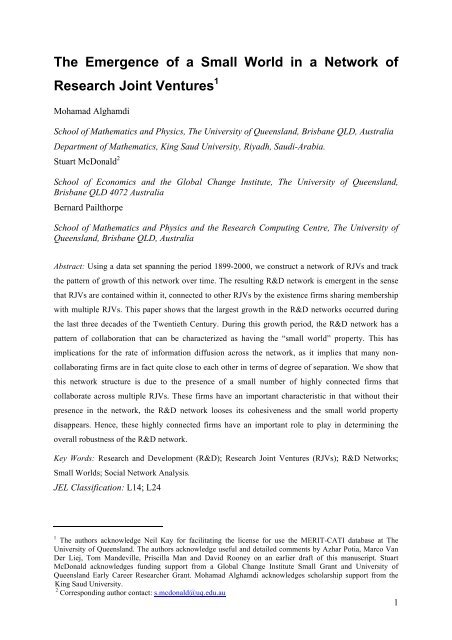


![Recycling [ PDF, 62KB ] - University of Queensland](https://img.yumpu.com/51805185/1/184x260/recycling-pdf-62kb-university-of-queensland.jpg?quality=85)

